The dynamics of the Mesolithic–Neolithic transition in Britain and Ireland have been intensively researched for many years and it continues to remain a contentious area of debate. In particular, as the introduction of agriculture is a key defining element of the Neolithic, the nature and significance of early farming has been a major focus of research (Bickle & Whittle Reference Bickle, Whittle, Whittle and Bickle2014; Rowley-Conwy & Legge Reference Rowley-Conwy, Legge, Fowler, Harding and Hofmann2015). Despite this, there remains little consensus on the speed of the transition from hunter-gathering to agriculture and the importance of arable agriculture in subsistence practices (Thomas Reference Thomas2014, 392; Rowley-Conwy & Legge Reference Rowley-Conwy, Legge, Fowler, Harding and Hofmann2015). Traditionally, these debates have revolved around whether the Neolithic was characterised by an abrupt shift to an intensive mixed farming regime, potentially associated with considerable immigration, or whether it was a more gradual process with emphasis placed on indigenous hunter-gatherers in adopting and diffusing selected aspects of agriculture (eg, Thomas Reference Thomas2004; Reference Thomas2007; Reference Thomas2014; Rowley-Conwy Reference Rowley-Conwy2004; Reference Rowley-Conwy2011; Sheridan Reference Sheridan2007; Reference Sheridan, Finlayson and Warren2010; Whittle et al. Reference Whittle, Healy and Bayliss2011; Rowley-Conwy & Legge Reference Rowley-Conwy, Legge, Fowler, Harding and Hofmann2015). In view of these debates, archaeobotanical research therefore has a key role in examining the nature and significance of Neolithic farming practices.
The introduction of cereals into Britain (c. 3950–3850 cal bc) and Ireland (c. 3750 cal bc) appears to have been a rapid and widespread process (Stevens & Fuller Reference Stevens and Fuller2012; Whitehouse et al. Reference Whitehouse, Schulting, McClatchie, Barratt, McLaughlin, Bogaard, Colledge, Marchant, Gaffrey and Bunting2014). This does not provide evidence for migration per se, but rather it is more consistent with models favouring colonisation by farming communities at the onset of the Neolithic (eg, Rowley-Conwy Reference Rowley-Conwy2004; Reference Rowley-Conwy2011; Sheridan Reference Sheridan, Finlayson and Warren2010; Stevens & Fuller Reference Stevens and Fuller2012; McLaughlin et al. Reference McLaughlin, Whitehouse, Schulting, McClatchie, Barratt and Bogaard2016; Brace et al. Reference Brace2019). However, a balance between migration and acculturation by indigenous hunter-gatherers should not be overlooked (eg, Whittle et al. Reference Whittle, Healy and Bayliss2011; Thomas Reference Thomas2014). For instance, the presence of cereals at a site does not necessarily indicate local cultivation and, in some instances, this may instead reflect the exchange of cereals (cf. Hillman Reference Hillman and Britnell1982; Deforce et al. Reference Deforce, Bastiaens, van Neer, Ervynck, Lentacker, Sergant and Crombé2013; Meylemans et al. Reference Meylemans, Bastiaens, Boudin, Defore, Ervynck, Perdaen, Sergant, Storme and Crombé2018). It is also evident that wild plant exploitation remained a significant component of subsistence practices (eg, Pelling & Campbell Reference Pelling, Campbell, Canti, Campbell and Gearey2013). Increasingly, it is recognised that wild plants were systematically and intensively exploited, possibly involving the deliberate management of woodlands/wild plants (Colledge & Conolly Reference Colledge and Conolly2014; Bishop et al. Reference Bishop, Church and Rowley-Conwy2015), blurring the traditional dichotomy between ‘hunter-gathering’ and ‘farming’ (Rowley-Conwy & Layton Reference Rowley-Conwy and Layton2011).
Whilst considerable research has examined the introduction of cereals, this has ‘overshadowed’ our understanding of the nature of farming regimes (Jones Reference Jones2005). It is unclear whether the introduction of cereals was part of an integrated ‘package’ characterised by an intensive mixed farming regime, with crop and animal husbandry closely integrated, as observed in south-east and central Europe (Bogaard Reference Bogaard2005; Halstead Reference Halstead, Serjeanston and Field2006). Alternatively, it has been suggested that cereal cultivation may have been ‘episodic or short-lived’ (Thomas Reference Thomas2003, 71). Understanding the nature of farming regimes has wider implications for how we understand the integration between animal and crop husbandry, the relative dietary importance of crops and animals, the organisation of household labour, and the ecological impact of farming (Bogaard Reference Bogaard2004). Recent research using weed ecology and cereal carbon (δ13C) and nitrogen (δ15N) isotope analysis provides significant potential to investigate the nature of farming regimes (Bogaard Reference Bogaard, Whittle and Bickle2014).
The introduction of cereals was probably a complex process, potentially involving numerous (re-) introductions and failed introductions (cf. Boivin et al. Reference Boivin, Fuller and Crowther2012). However, less research has examined long-term trends in the importance of cereals, especially during the later Neolithic period (Whitehouse & Kirleis Reference Whitehouse and Kirleis2014; McClatchie et al. Reference McClatchie, Bogaard, Colledge, Whitehouse, Schulting, Barratt and McLaughlin2016). Stevens and Fuller (Reference Stevens and Fuller2012) have drawn attention to evidence for a significant decline, or even an abandonment, of cereal cultivation in later Neolithic Britain. This large-scale narrative may, however, obscure subtle and important regional diversity in the importance of cereals (Bishop Reference Bishop2015; Worley et al. Reference Worley, Madgwick, Pelling, Marshall, Evans, Lamb, López-Dóriga, Ramsey, Dunbar, Reimer and Vallender2019). Therefore, the importance of regional approaches is increasingly being recognised (cf. Bell Reference Bell and Bell2007a, 17; Bishop Reference Bishop2015; Griffiths Reference Griffiths2018).
This paper focuses on the introduction of agriculture into Wales, a predominantly mountainous area in western Britain. Situated at the intersection between several regions, notably the Irish Sea Zone to the west and mainland Britain to the east, Wales represents an important area for understanding the onset and diffusion of the Neolithic (eg, Lynch Reference Lynch2000; Sheridan Reference Sheridan2007; Reference Sheridan, Finlayson and Warren2010; McLaughlin et al. Reference McLaughlin, Whitehouse, Schulting, McClatchie, Barratt and Bogaard2016; Garrow et al. Reference Garrow, Griffiths, Anderson-Whymark and Sturt2017). However, Neolithic farming practices in Wales have received very little attention and there has been an over-reliance on evidence from a handful of well-known sites. Recently, the quantity of archaeobotanical research undertaken on Neolithic sites in Wales has significantly increased, largely due to developer-funded archaeology. This can be contrasted with well-studied areas such as southern England (Pelling & Campbell Reference Pelling, Campbell, Canti, Campbell and Gearey2013), Ireland (McClatchie et al. Reference McClatchie, Bogaard, Colledge, Whitehouse, Schulting, Barratt and McLaughlin2014; Reference McClatchie, Bogaard, Colledge, Whitehouse, Schulting, Barratt and McLaughlin2016), and Scotland (Bishop et al. Reference Bishop, Church and Rowley-Conwy2009; Bishop Reference Bishop2015), as well as continental Europe (eg, Colledge & Conolly Reference Colledge and Conolly2007; Salavert Reference Salavert2011; Kirleis et al. Reference Kirleis, Klooß, Kroll and Müller2012; Kirleis & Fischer Reference Kirleis and Fischer2014; Sørensen & Karg Reference Sørensen and Karg2014).
We review the archaeobotanical evidence from 95 Neolithic sites, focusing on wild plant use, the introduction and significance of cereals, the nature of cereal cultivation practices, and evidence for a later Neolithic cereal decline. A pilot study using stable carbon (δ13C) and nitrogen (δ15N) isotope analysis of Early Neolithic cereal grains was undertaken to provide new information on cultivation practices. The archaeobotanical and cereal isotope evidence is then considered in a regional and European research context.
ENVIRONMENTAL AND ARCHAEOLOGICAL CONTEXT: NEOLITHIC WALES
Recent developer-funded projects and research excavations undertaken across Wales have led to the discovery of important Neolithic sites. Consequently, a brief overview of the current state of research is necessary. Table 1 presents the chronological periods used in this study.
TABLE 1: CHRONOLOGICAL PERIODS FOR NEOLITHIC BRITAIN USED IN THIS PAPER
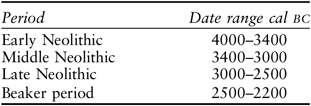
There is no defined period name for 2500–2200 cal bc, so the term Beaker period used here is interchangeable with ‘Chalcolithic’
Though dating evidence is patchy, the Mesolithic–Neolithic transition can be dated to within the centuries either side of c. 3700 cal bc in south Wales and the Marches, and probably also in north Wales (Whittle et al. Reference Whittle, Healy and Bayliss2011). However, recent evidence from Dorstone Hill, Herefordshire, in the Welsh Marches, suggests a slightly earlier date for the Early Neolithic (Ray & Thomas Reference Ray and Thomas2018). Sea-routes in this area of western Britain are recognised as an ‘important corridor of interaction’ and the archaeological record reflects this (eg, Lynch Reference Lynch2000; Thomas Reference Thomas2003; Cummings & Whittle Reference Cummings and Whittle2004; Sheridan Reference Sheridan2007; Reference Sheridan, Finlayson and Warren2010; McLaughlin et al. Reference McLaughlin, Whitehouse, Schulting, McClatchie, Barratt and Bogaard2016; Garrow et al. Reference Garrow, Griffiths, Anderson-Whymark and Sturt2017, 103). Notably, similarities exist between west Wales and the wider Irish Sea Zone, whereas eastern areas of Wales are more comparable to mainland Britain (eg, Lynch Reference Lynch2000; Cummings & Whittle Reference Cummings and Whittle2004). It is important to consider this regional diversity when analysing the introduction of cereals. Recent interpretations emphasise a combination of both indigenous adoption and migration in the Neolithic transition and strontium isotope analysis of human remains from south-east Wales hint at migration in the earliest phases (Neil et al. Reference Neil, Montgomery, Evans, Cook and Scarre2017).
The Early Neolithic period is characterised by a significant change in the archaeological record (Burrow Reference Burrow2003). Various monumental and funerary sites including cursus monuments, megalithic tombs and causewayed enclosures were constructed during this period (Schulting & Whittle Reference Schulting, Whittle, Burenhult and Westergaard2003; Jones Reference Jones2009; Reference Jones2012; Davis & Sharples Reference Davis and Sharples2017), though few have been recently and extensively excavated (Burrow Reference Burrow2003). Recent excavations confirm the presence of causewayed enclosures at Womaston in central Wales, Caerau in south-east Wales, and Banc Du in south-west Wales (Davis & Sharples Reference Davis and Sharples2017). However, archaeobotanical evidence has only been published from Womaston at present (Jones Reference Jones2009).
Early Neolithic occupation sites primarily comprise surface finds and ephemeral traces of activity, notably pits/pit groups (Kenney Reference Kenney2008). Pits/pit groups are characteristic site-types defined by small, shallow groups of charcoal-rich pits often containing pottery, which have been interpreted as containing occupation debris and, in some cases, structured deposits (Anderson-Whymark & Thomas Reference Anderson-Whymark and Thomas2012). Evidence for rectangular structures/houses has considerably increased in recent years with several examples now known and this can be compared with the more extensive evidence for these structures in Ireland (eg, Britnell Reference Britnell, Britnell and Savory1984; Kenney Reference Kenney2008; Kenney et al. Reference Kenney, McGuinness, Cooke, Rees and Davidson2011; Barber & Hart Reference Barber and Hart2014; Smyth Reference Smyth2014; Rees & Jones Reference Rees and Jones2015). In terms of land use, the degree of mobility in settlement patterns is debated, though it appears that some sites were not occupied permanently (Neil et al. Reference Neil, Evans, Montgomery and Scarre2016).
Pollen studies have recorded relatively little evidence for substantial human impact on environments in the Early Neolithic, despite widespread archaeological evidence for activity (eg, Chambers Reference Chambers1982; Mighall & Chambers Reference Mighall and Chambers1995; Caseldine Reference Caseldine and Bell2000; Reference Caseldine2014; Innes et al. Reference Innes, Blackford and Chambers2006; Walker et al. Reference Walker, Jones, Hussey and Buckley2006; Fyfe Reference Fyfe2007; Watkins et al. Reference Watkins, Scourse and Allen2007; Grant Reference Grant2008; Woodbridge et al. Reference Woodbridge, Fyfe, Law and Haworth-Johns2012; Brown Reference Brown and Bell2013; Murphy et al. Reference Murphy, Caseldine, Barker, Fielding, Burrow and Carlsen2015; Caseldine et al. Reference Caseldine, Griffiths, Jones, Peck and Smith2016; Reference Caseldine, Griffiths, Roberts, Smith and Williams2017). Small-scale, temporary clearances, occasionally associated with cereal-type pollen, are recorded, however, these do not appear to differ significantly in character from vegetation disturbances witnessed in the preceding Mesolithic (Bell Reference Bell and Bell2007b, 340). The elm decline is a key feature of pollen records spanning this period. This decline is now attributed to a multi-causal model which emphasises the impact of both natural and anthropogenic factors (Parker et al. Reference Parker, Goudie, Anderson, Robinson and Bonsall2002; Innes et al. Reference Innes, Blackford and Chambers2006; Batchelor et al. Reference Batchelor, Branch, Allison, Austin, Bishop, Brown, Elias, Green and Young2014). Evidence for Early Neolithic activity may be overlooked or under-represented in regional pollen studies since woodland clearings may have been too small to detect (Whitehouse & Smith Reference Whitehouse and Smith2010; Bell & Noble Reference Bell, Noble, Jones, Pollard, Allen and Gardiner2012) and due to the poor dispersal of cereal pollen (Hall Reference Hall1989). In addition, many pollen sequences are from upland zones and coastal wetlands, whereas there is more substantial evidence for Early Neolithic activity in lowland, inland areas (Fig. 1: Bell Reference Bell and Bell2007a, 17).
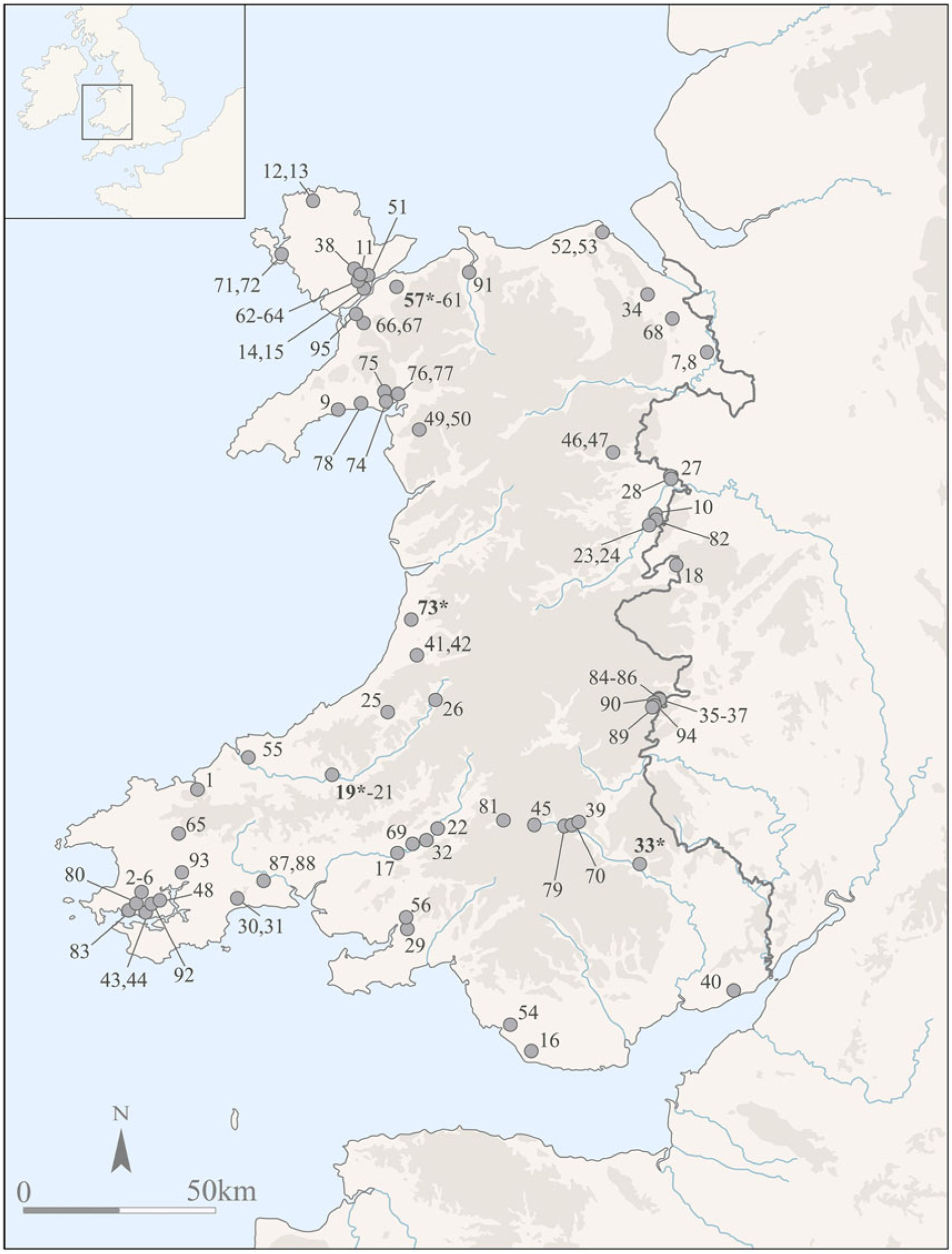
Fig. 1. Distribution of sites with archaeobotanical evidence. Site numbers are presented in Table S1. Cereal grains were sampled for stable isotope analysis at sites denoted with a ‘*’ in bold
For the later Neolithic period (Middle–Late Neolithic, c. 3400–2500 cal bc) and Beaker period (c. 2500–2000 cal bc), pits/pit groups represent typical evidence for ‘occupation’ whilst evidence for structures is rare (eg, Britnell Reference Britnell1982; Gibson Reference Gibson1999; Kenney Reference Kenney2008). It is suggested that communities were (semi-)mobile (Peterson Reference Peterson, Cummings and Fowler2004; Halsted Reference Halsted and Garwood2007). The Late Neolithic to Beaker period is characterised by the construction of numerous monuments, including henges, ring-ditches, and major palisaded enclosures (eg, Britnell & Jones Reference Britnell and Jones2012; Barber & Hart Reference Barber and Hart2015; Jones & Gibson Reference Jones and Gibson2017). Extensive evidence for activity in this period comes from burnt mounds, though the function of these sites is debated and their relationship to settlement activity is unclear (Halsted Reference Halsted and Garwood2007, 174; Kenney Reference Kenney, Britnell and Silvester2012; Hart et al. Reference Hart, Rackham, Griffiths and Challinor2014; Brown et al. Reference Brown, Davis, Hatton, O’Brien, Reilly, Taylor, Dennehy, O’Donnell, Bermingham, Mighall, Timpany, Tetlow, Wheeler and Wynne2016). Pollen studies for the Middle–Late Neolithic suggest an increase in woodland regeneration in some areas, followed by increasing impact which broadly begins in the Beaker period/Early Bronze Age, extending to the later Bronze Age (eg, Chambers & Price Reference Chambers and Price1988; Mighall & Chambers Reference Mighall and Chambers1995; Nayling & Caseldine Reference Nayling and Caseldine1997; Watkins et al. Reference Watkins, Scourse and Allen2007; Brown Reference Brown and Bell2013; Caseldine Reference Caseldine2014; Caseldine et al. Reference Caseldine, Griffiths, Roberts, Smith and Williams2017).
RECONSTRUCTING CEREAL CULTIVATION PRACTICES THROUGH STABLE CARBON (δ13c) AND NITROGEN (δ15N) ISOTOPE ANALYSIS
Archaeobotanical weed data can be used to investigate cultivation practices, however, a key challenge is the rarity of weed seeds in Neolithic archaeobotanical assemblages, particularly in Britain (Bogaard Reference Bogaard, Whittle and Bickle2014; Stevens & Fuller Reference Stevens, Fuller, Lightfoot, Liu and Fuller2018). Stable carbon (δ13C) and nitrogen (δ15N) isotope analysis of cereals provides a method for directly investigating cultivation practices, especially manuring (Bogaard Reference Bogaard, Whittle and Bickle2014).
Manuring can significantly elevate soil δ15N values and cereal δ15N values largely reflect the soil in which they are cultivated, as opposed to pulse crops which assimilate atmospheric nitrogen via N2-fixation (Fraser et al. Reference Fraser, Bogaard, Heaton, Charles, Jones, Christensen, Halstead, Merbach, Poulton, Sparkes and Styring2011; Treasure et al. Reference Treasure, Church and Gröcke2016). Bogaard et al. (Reference Bogaard, Fraser, Heaton, Wallace, Vaiglova, Charles, Jones, Evershed, Styring, Andersen and Arbogast2013) define three different levels of manuring intensity based on cereal δ15N values: ‘none or low’ (<3‰ δ15N), ‘medium’ (3–6‰ δ15N) and ‘high’ (>6‰ δ15N). ‘High’ cereal δ15N values (>6‰) are thought to reflect long-term, intensive manuring since short-term manuring (ie, 1–2 years) may not significantly impact cereal δ15N values (Fraser et al. Reference Fraser, Bogaard, Heaton, Charles, Jones, Christensen, Halstead, Merbach, Poulton, Sparkes and Styring2011). Other potential causes of 15N-enrichment require further research, such as environmental factors (ie, waterlogging), use of other manure/soil-amendments (ie, human faeces, middening), vegetation burning, and variation in baseline Neolithic soil δ15N values (cf. Szpak Reference Szpak2014). A baseline δ15N value for Neolithic soil can be estimated by analysing the δ15N values of wild herbivores recovered from the same site/period (Gron et al. Reference Gron, Gröcke, Larsson, Sørensen, Larsson, Rowley-Conwy and Church2017; Aguilera et al. Reference Aguilera, Zech-Matterne, Lepetz and Balasse2017; Styring et al. Reference Styring, Rösch, Stephan, Stika, Fischer, Sillmann and Bogaard2017). Wild herbivore δ15N values are not available for the sites analysed in Early Neolithic Wales. However, for Neolithic sites in southern Britain, an average δ15N value for deer bone collagen of 5.2‰ has been recorded (Stevens et al. Reference Stevens, Lightfoot, Allen and Hedges2012) and using a trophic-level enrichment of 3–5‰ (Bocherens & Drucker Reference Bocherens and Drucker2003) places the δ15N values for Neolithic soils at c. 0–2‰ (ie, low/no manuring range). Cereal δ13C values reflect atmospheric CO2 assimilation and water availability in the soil and this can be used alongside cereal δ15N values to investigate cultivation practices, soil conditions and environmental factors (Fiorentino et al. Reference Fiorentino, Ferrio, Bogaard, Araus and Riehl2015).
The impact of charring and contamination is an important consideration in the application of δ13C and δ15N analysis to archaeological charred cereal grains. Low temperature charring, which produces morphologically well-preserved and minimally distorted cereal grains, has a small impact on cereal δ13C values (up to +0.2‰) and δ15N values (up to +0.6‰; Nitsch et al. Reference Nitsch, Charles and Bogaard2014). Contamination and pre-treatment methods can cause small variations in cereal δ13C and δ15N values, though various studies have reported no consistent and significant differences between pre-treated and non-treated samples (Lightfoot & Stevens Reference Lightfoot and Stevens2012; Styring et al. Reference Styring, Maier, Stephan, Schlichtherle and Bogaard2016; Aguilera et al. Reference Aguilera, Zech-Matterne, Lepetz and Balasse2017; Brinkkemper et al. Reference Brinkkemper, Braadbaart, van Os, van Hoesel, van Brussel and Fernandes2018).
ARCHAEOBOTANICAL REVIEW METHODOLOGY
Archaeobotanical data was collated from published and unpublished sources. Contextual information was recorded for each site (region, location, period, dating evidence, site-type, feature/context type, date excavated/published, references). Plant remains were recovered by bulk sampling and flotation. The majority of archaeobotanical data derives from sites where full site/excavation reports are available and where full analysis of archaeobotanical data has been undertaken. For a small number of sites, the archaeobotanical evidence derives from the ‘assessment’ stage as this is the only work undertaken to date. ‘Assessments’ typically comprise the quick review of all the samples within an assemblage to assess their nature, significance and potential. This can provide valuable information about the nature of an archaeobotanical assemblage (eg, the presence/absence of cereal-rich contexts). The full dataset is presented in Supplementary Data Tables S1 and S2 and site locations are plotted in Figure 1.
The integrity of archaeobotanical samples from Neolithic sites needs to be closely examined to account for issues of contamination (Stevens & Fuller Reference Stevens and Fuller2012; Reference Stevens and Fuller2015; Bishop Reference Bishop2015; Pelling et al. Reference Pelling, Campbell, Carruthers, Hunter and Marshall2015). An extreme option would be to only include samples with directly-dated plant remains (eg, Stevens & Fuller Reference Stevens and Fuller2012), however, such an approach would result in a very small dataset. To account for this issue, a distinction was made between sites with archaeobotanical data classified as having either secure or good dating evidence and sites where archaeobotanical data is moderately well-dated, though it can still be assigned to a specific period. Full details of this site-selection methodology are provided in Table S1. Samples which were undated, poorly phased, or contaminated are excluded and consequently the archaeobotanical data may differ slightly from that in the original reports.
Table S2 summarises the archaeobotanical data (preservation type, samples, quantity of plant remains). To standardise the dataset, three cereal grain fragments were recorded as one cereal grain and spikelet forks were recorded as two chaff fragments. To provide information on cereal cultivation conditions/practices, potential arable weeds were recorded on a context-by-context basis for contexts containing ≥10 cereal remains (grain, chaff; cf. Bogaard & Jones Reference Bogaard, Jones, Whittle and Cummings2007, 367). Nomenclature follows Stace (Reference Stace2010).
CEREAL GRAIN STABLE CARBON (δ13C) AND NITROGEN (δ15N) ISOTOPE ANALYSIS METHODOLOGY
Stable carbon (δ13C) and nitrogen (δ15N) isotope analysis was undertaken on 51 charred cereal grains (emmer wheat & barley) from four Early Neolithic sites: Plas Gogerddan (Site 73: Caseldine Reference Caseldine and Murphy1992), Gwernvale (Site 33: Caseldine in prep.), Parc Bryn Cegin (Site 57: Schmidl et al. Reference Schmidl, Carrott, Jaques and Kenney2008), and Cwm Meudwy (Site 19: Caseldine & Griffiths Reference Caseldine, Griffiths, Murphy and Evans2006). See Table 2 and Table S4 for full details of the sites.
TABLE 2: CEREAL GRAIN SAMPLES FROM EARLY NEOLITHIC SITES
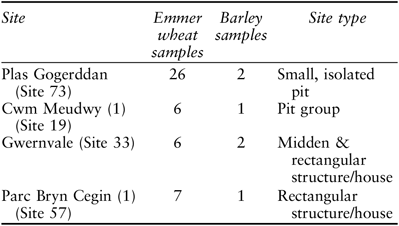
Following the methodological justification outlined by Gron et al. (Reference Gron, Gröcke, Larsson, Sørensen, Larsson, Rowley-Conwy and Church2017), each sample is an individual cereal grain, opposed to bulk samples of >10 grains (eg, Bogaard et al. Reference Bogaard, Fraser, Heaton, Wallace, Vaiglova, Charles, Jones, Evershed, Styring, Andersen and Arbogast2013). Each cereal grain was measured, and the degree of preservation/distortion noted, following Hubbard and al-Azm (1990). Most grains were well-preserved (80%: P2/P3) with little distortion (80%: D2). Changes in cereal δ13C and δ15N values introduced by charring are therefore likely to be small. No offset has been applied to cereal δ13C and δ15N values to account for charring due to potentially wide and unknown variation in charring conditions and potential variability in δ13C and δ15N in a single cereal plant/field. Adhering sediment on the grains was minimal/not present and this was removed by gentle scraping. Each grain was halved and homogenised in an agate pestle and mortar. Samples were not pre-treated to remove potential contaminants or screened for contamination using Fourier transform infrared spectroscopy (FTIR). Brinkkemper et al. (Reference Brinkkemper, Braadbaart, van Os, van Hoesel, van Brussel and Fernandes2018) indicate that reliable δ13C and δ15N measurements of cereal grains can be obtained from untreated samples which are cleaned of visible adhering sediment, provided that grains are not heavily encrusted in sediment.
Stable isotope measurements, total organic carbon, and total nitrogen content of the samples were undertaken in the Stable Isotope Biogeochemistry Laboratory (SIBL) at Durham University using a Costech Elemental Analyser (ECS 4010) connected to a Thermo Scientific Delta V Advantage isotope ratio mass spectrometer. Carbon isotope ratios are corrected for 17O contribution and reported in standard delta (δ) notation in per mil (‰) relative to Vienna Pee Dee Belemnite (VPDB). Nitrogen isotope ratios are reported at atmospheric nitrogen (AIR). Isotopic accuracy was monitored through routine analyses of in-house standards (glutamic acid, δ13C = −11‰, δ15N = −7.5‰; urea, δ13C = −43.3‰, δ15N = –0.56‰; spar calcite, δ13C = 2.9‰), which were stringently calibrated against international standards (eg, USGS40, USGS24, IAEA-600, IAEA-N-1, IAEA-N-2): this provided a linear range in δ13C between −44‰ and 3‰ and in δ15N between −7.5‰ and 20.4‰. Analytical variation in carbon and nitrogen isotope analyses was typically ±0.1‰ for replicate analysis of the international standards and typically <0.2‰ on replicate sample analysis. Total organic carbon and nitrogen data was obtained as part of the isotopic analysis using an internal standard (glutamic acid, 40.82% C, 9.52% N).
To compare cereal δ13C values from different chronological periods it is necessary to account for changes in the δ13C of atmospheric CO2 throughout the Holocene. The δ13C of atmospheric CO2 was estimated using the AIRCO2_LOESS system (Ferrio et al. Reference Ferrio, Araus, Buxó, Voltas and Bort2005) and carbon isotope discrimination (Δ13C) independent of source CO2 was calculated following Farquhar et al. (Reference Farquhar, Ehleringer and Hubick1989).
RESULTS
Overview: site types, sampling and archaeobotanical data recorded
Archaeobotanical evidence was collated from 95 sites (Fig. 1), comprising 28 Early Neolithic, 18 Middle Neolithic, 22 Late Neolithic, and 27 Beaker period sites. Secure/very well-dated archaeobotanical assemblages were present at 50 sites and archaeobotanical assemblages with good/moderate dating evidence were present at a further 45 sites. The distribution of sites primarily reflects the location of developer-funded archaeological projects, particularly in southern areas and in the north-west. Most sites are in lowland areas, with some clustering around river valleys, whereas few sites are in the more mountainous central region. Charred plant remains are the most common form of evidence and waterlogged plant remains were recorded at one site: Llandevenny (Site 40: Brown Reference Brown and Bell2007a). Pottery impressions of plant remains were present at one site: Ogmore-by-Sea (Site 54: Burrow Reference Burrow2003). Plant remains were absent (excluding wood charcoal) at 16 sites, despite bulk sampling and flotation.
A wide range of site-types have been sampled (Table 3). Pits/pit group sites were the most frequently sampled for all periods, whilst only a small number of structures/houses have been sampled for the Early Neolithic (four sites) and Late Neolithic (two sites). A larger quantity of data is available from funerary/monumental sites and burnt mounds for the Late Neolithic and Beaker period. Where information was available, the number of samples analysed was typically small (≤5) which primarily reflects the small number of Neolithic features excavated at many sites. More extensive sampling (>20 samples) has only been undertaken at four sites: Parc Bryn Cegin (1) (Site 57: Schmidl et al. Reference Schmidl, Carrott, Jaques and Kenney2008), Parc Bryn Cegin (2) (Site 58: Schmidl et al. Reference Schmidl, Carrott, Jaques and Kenney2008), Upper Ninepence (Site 84: Caseldine Reference Caseldine and Gibson1999), and Vaynor Henge (Site 88: Rackham Reference Rackham, Barber and Hart2015).
TABLE 3: SITE TYPES WITH ARCHAEOBOTANICAL EVIDENCE FOR EACH PERIOD
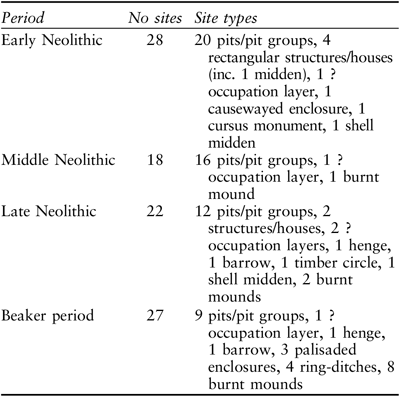
Detailed descriptions of the sites and contexts are provided in Table S4
Figures 2 and 3 summarise the plant remains for each period by site type. Hazel nutshell (Corylus avellana L.) is the most frequently recorded plant remain and was present at 21 Early Neolithic sites, 17 Middle Neolithic, 15 Late Neolithic, and 15 Beaker period sites. Other wild fruits and nuts (excluding hazel nutshell) were less frequently recorded. For all periods, wild plant remains were present at a range of site types. Cereal grains were commonly recorded in the Early Neolithic (16 sites), though chaff was rarer (10 sites). Evidence for cereals in the Early Neolithic comes from pits/pit groups (11 sites), structures/houses (3 sites), a causewayed enclosure (1 site) and one shell midden (1 site). For the Middle Neolithic, Late Neolithic, and Beaker periods, cereal grains and chaff are rarer and the evidence primarily derives from pits/pit groups. Evidence for other crops was very rare: Celtic bean (Vicia faba L.) was recorded at one Middle Neolithic site (pottery impression at Ogmore-by-Sea, Site 54: Burrow Reference Burrow2003) and one Late Neolithic site (Capel Eithin, Site 11: Williams Reference Williams, White and Smith1999), whilst flax (Linum usitatissimum L.) was recorded at one Beaker period site (Buttington Cross, Site 10: Clapham Reference Clapham, Mann and Hurst2009). Direct AMS 14C dating has not been undertaken for the Celtic bean or flax remains. Weed seeds and other plant remains were commonly recorded, some of which may be arable weeds (see below).
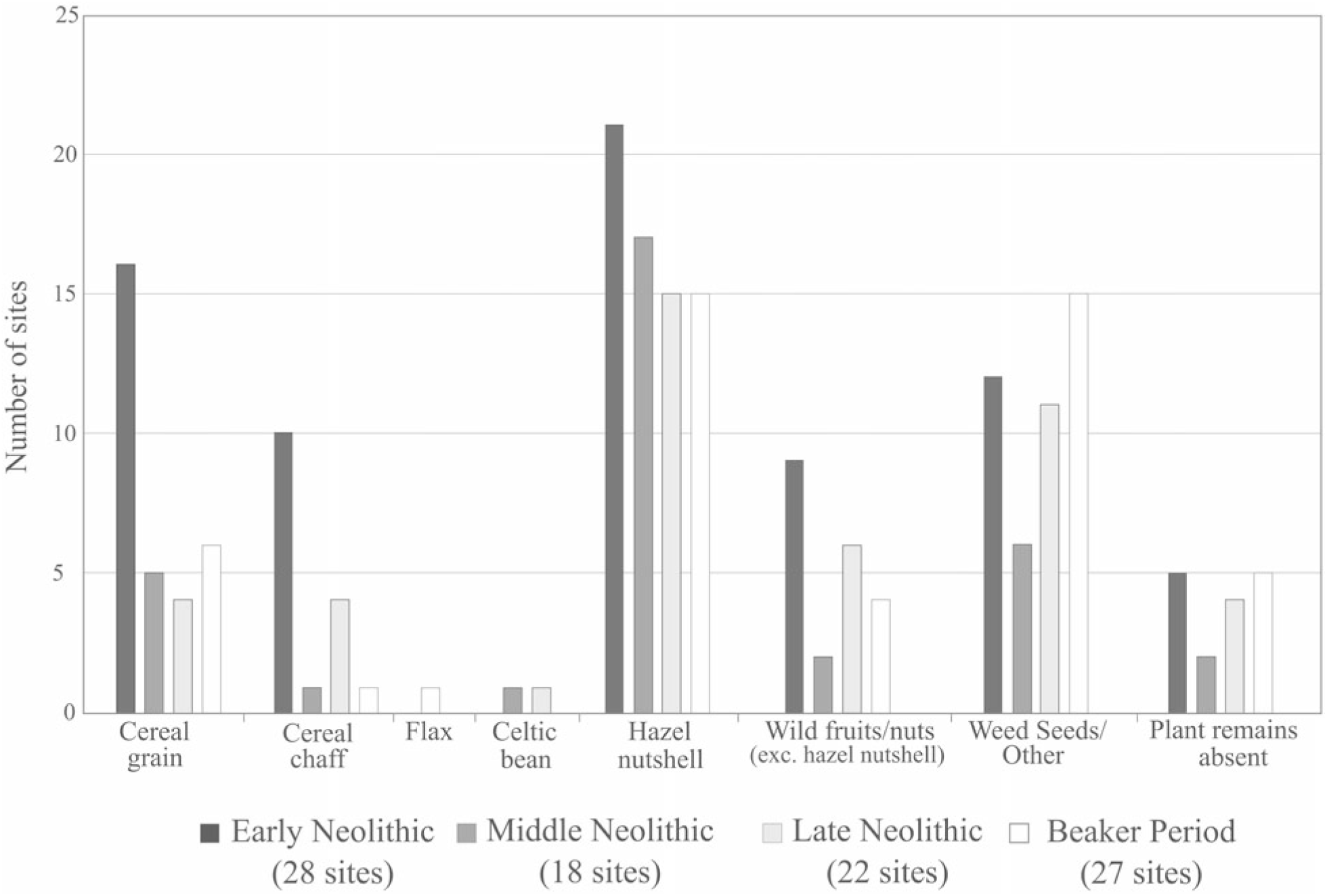
Fig. 2. Summary of plant remains recorded
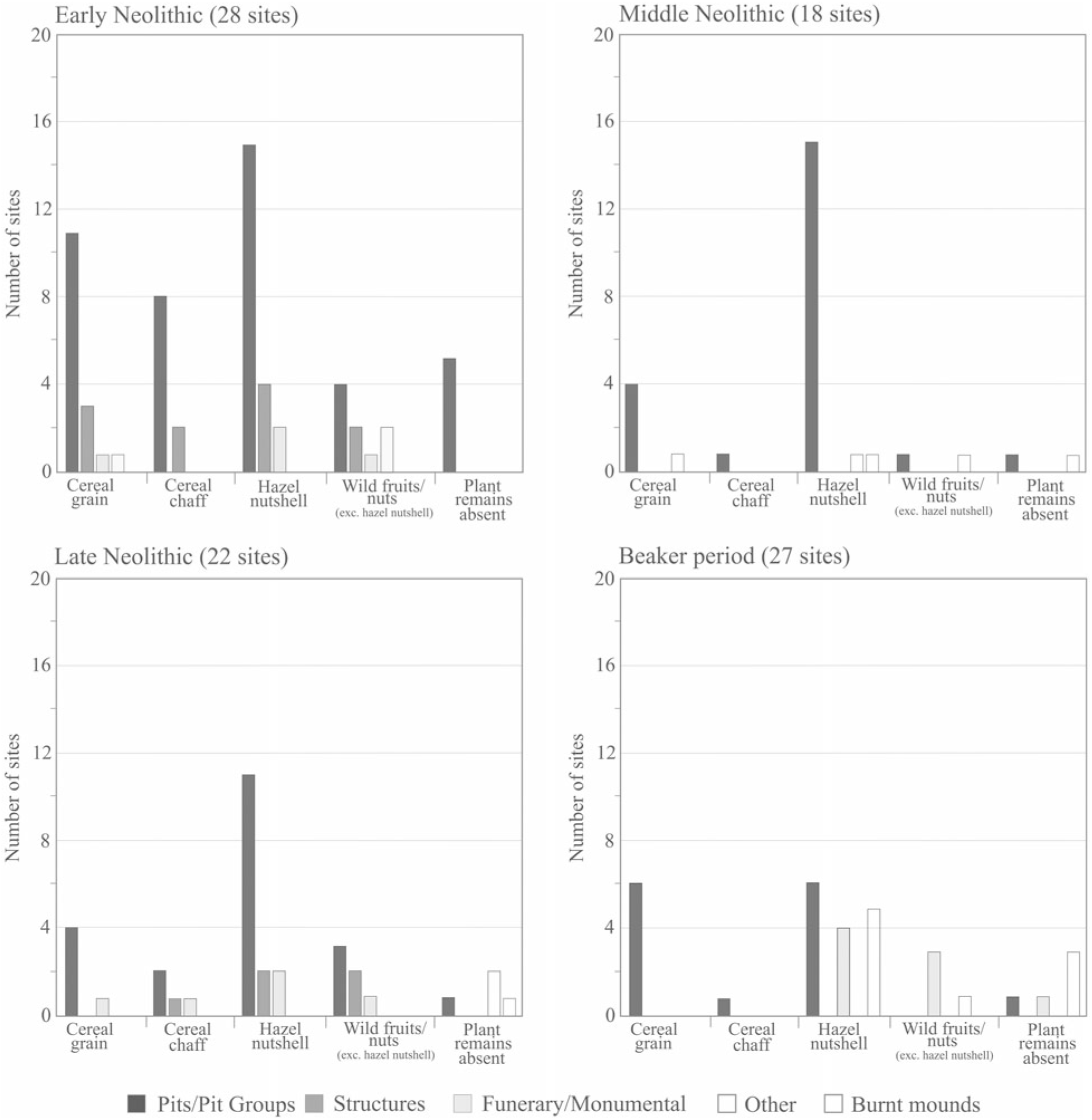
Fig. 3. Summary of plant remains recorded by site type. Number of sites (in parentheses) refers to the total number of sites for each period
Wild plants recorded
Hazel nutshell fragments were frequently recovered for all periods (Fig. 2), though the quantity and density of shell fragments varied significantly between different site types (see Table 4 for illustrative examples). In general, pits/pit groups sites typically produced high or very high densities of hazel nutshell. High densities of hazel nutshell were also present in the probable Early Neolithic structure at Cwmifor (Site 22: Rackham Reference Rackham, Barber and Hart2014), though a low density of hazel nutshell was recorded at Parc Bryn Cegin (Site 57: Schmidl et al. Reference Schmidl, Carrott, Jaques and Kenney2008). Overall, hazel nutshell typically occurs in higher densities in ‘occupation’ sites (pits, structures) and in lower densities in other site types, notably funerary and monumental sites.
TABLE 4: SUMMARY OF HAZEL NUTSHELL DATA FROM SELECTED SITES WHERE INFORMATION ON THE SAMPLE VOLUME WAS AVAILABLE
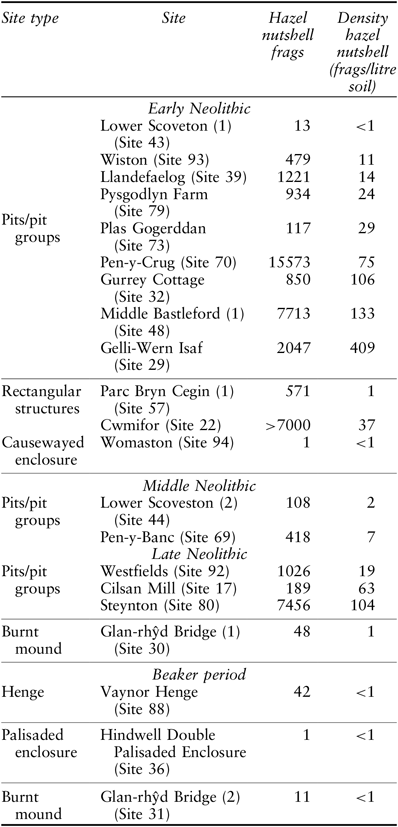
The density of hazel nutshell is expressed relative to litres of soil processed and displayed by site type
Evidence for other wild plant remains (fruits and nuts, excluding hazel nutshell) was rarer (Fig. 4) and was present at nine Early Neolithic sites, two Middle Neolithic sites, six Late Neolithic sites, and four Beaker period sites. The commonly recorded fruits were raspberry/blackberry (Rubus idaeus L./R. fruticosus L. agg.) and crab apple (Malus sylvestris L. Mill.). Charred acorn (Quercus sp.) remains (cotyledons, nutshell fragments, cupules) have been recorded in small quantities at six sites (1 Early Neolithic, 1 Middle Neolithic, 2 Late Neolithic, and 2 Beaker period sites). Evidence for other wild fruits including hawthorn (Crataegus monogyna Jacq.), sloe (Prunus spinosa L.), and elder (Sambucus nigra L.) were only rarely recorded. Other plants recorded in the ‘weed seed and other’ category may also include deliberately gathered plants (Behre Reference Behre2008), for instance, selfheal (Prunella vulgaris L.), black-bindweed (Fallopia convolvulus (L.) Á. Löve), and sheep’s sorrel (Rumex acetosella L.).
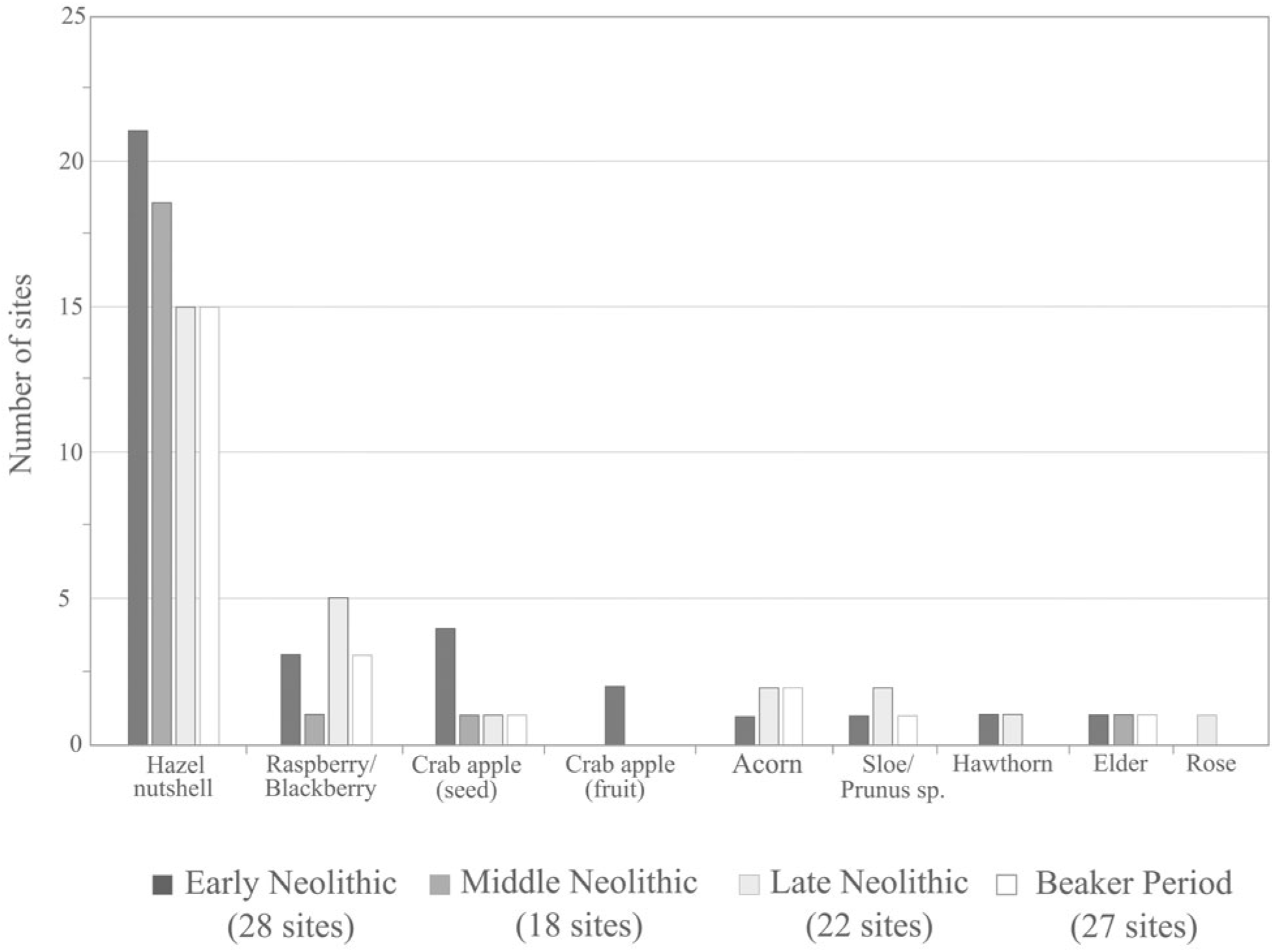
Fig. 4. Wild plants recorded
Cereal types recorded
Figure 5 summarises the relative occurrence of different cereal types at sites. For the Early Neolithic, emmer wheat (Triticum dicoccum L.) was the most frequent cereal type (recorded at 11/16 sites), whilst barley (Hordeum sp.) was recorded at 9/16 sites (both hulled and naked type were recorded). Oat (Avena sp.) and naked wheat (Triticum aestivum L./T. durum Desf./T. turgidum L.), are less frequently recorded in Early Neolithic sites. For Middle Neolithic sites, cereals recorded include barley and wheat (emmer wheat, indeterminate glume wheat (Triticum sp.), naked wheat). Similarly, for the Late Neolithic, barley (both hulled and naked types), wheat (emmer wheat, indeterminate glume wheat, naked wheat), and oat are recorded. For the Beaker period, barley (only hulled barley confirmed) and wheat (naked wheat) were recorded.
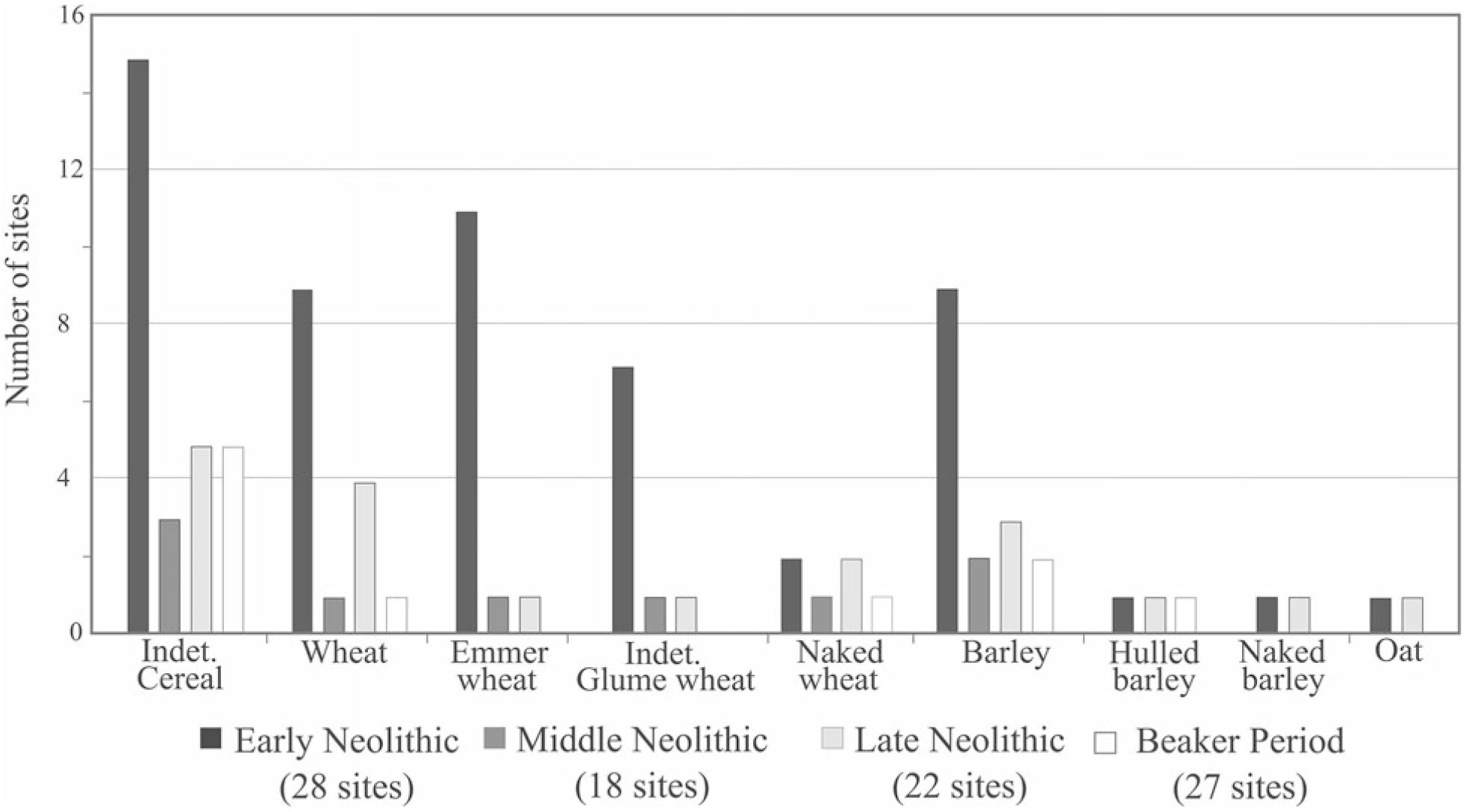
Fig. 5. Cereal types recorded
Figure 6 provides a comparison between the relative proportions of different cereal types for sites which produced >10 cereal remains (grains and chaff). This data was available for ten Early Neolithic and one Late Neolithic site. For the Early Neolithic period, wheat, most likely emmer, is the dominant cereal type and barley only forms a small proportion of most cereal assemblages. Naked wheat forms only a very small portion of cereal assemblages. For the Late Neolithic, data are only available from Capel Eithin (Site 11: Williams Reference Williams, White and Smith1999). The cereal assemblage from this site differs from other Early Neolithic assemblages as it is dominated by barley, primarily naked barley, and there is minimal evidence for other cereal types including wheat (naked wheat, emmer) and oat. One sample which produced a rye grain (Secale cereale L.) and oat, including bristle oat (Avena strigosa Schreb.), is excluded since these remains are almost certainly intrusive.
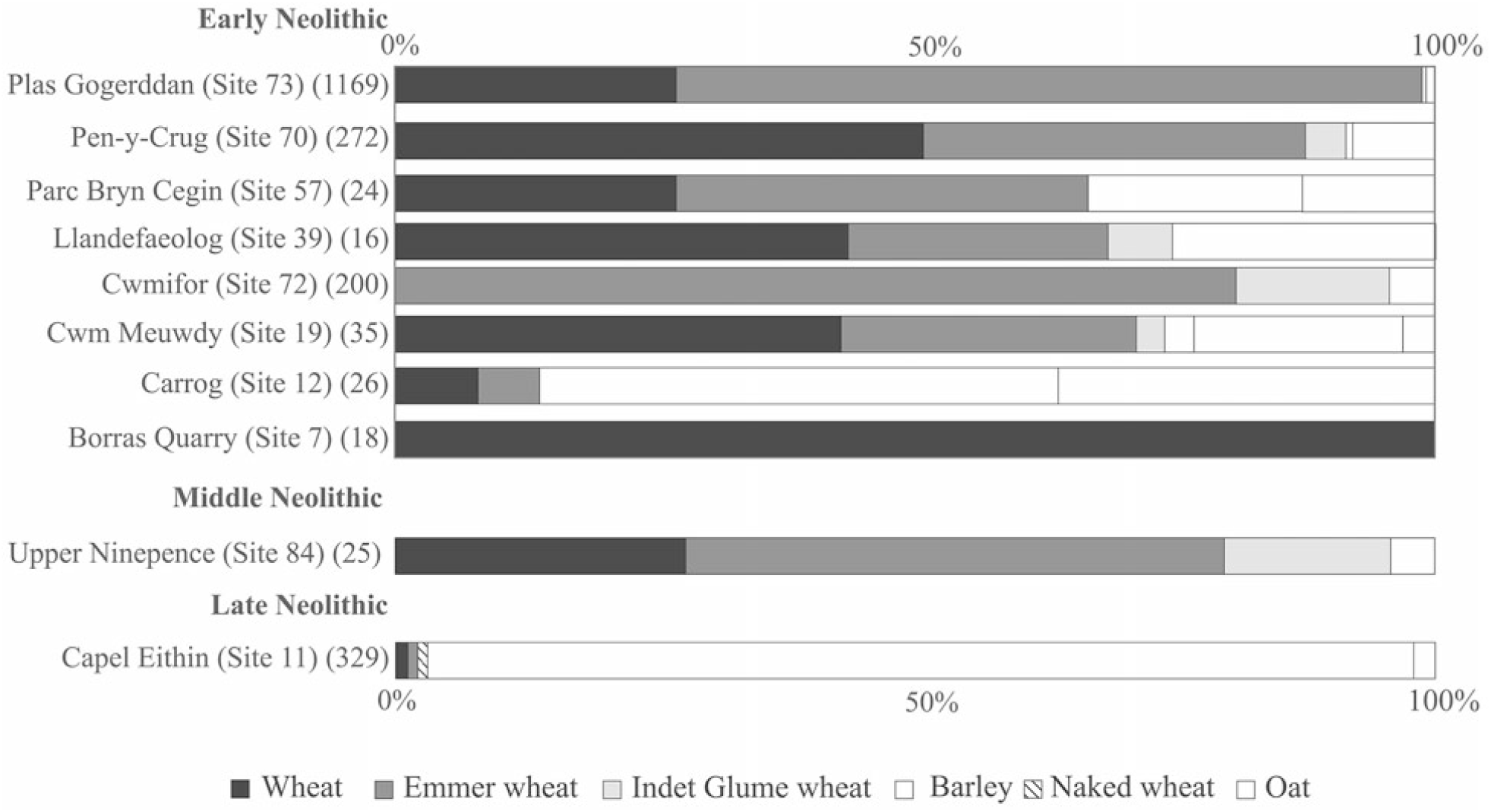
Fig. 6. Proportions of different cereal types at sites where >10 identifiable cereals remains (grains, chaff) were present. The number in parentheses indicates the quantity of identifiable cereal remains recovered
Quantity of cereal remains
Information on the quantity of cereals (grains and chaff) was available for most sites and this is summarised in Figure 7 in relation to the number of samples analysed. Both grains and chaff occur in larger quantities in Early Neolithic sites, which typically produced small assemblages of cereal grains consisting of ≤50 cereal grains (8/14 sites), whilst chaff was significantly rarer and most sites (8/10) produced ≤5 chaff remains. For the Early Neolithic, 50–100 grains were recorded at three sites and >100 grains were recorded at three sites, whilst >100 chaff remains were recorded at one site. In comparison to the Early Neolithic, cereals (grains and chaff) occur in smaller quantities in the Middle Neolithic, Late Neolithic, and Beaker period. For instance, ≤20 grains and chaff were recorded at all Middle Neolithic sites, most Late Neolithic sites, and all Beaker period sites. One Late Neolithic site, Capel Eithin (Site 11: Williams Reference Williams, White and Smith1999), produced a large cereal assemblage (>100 grains).
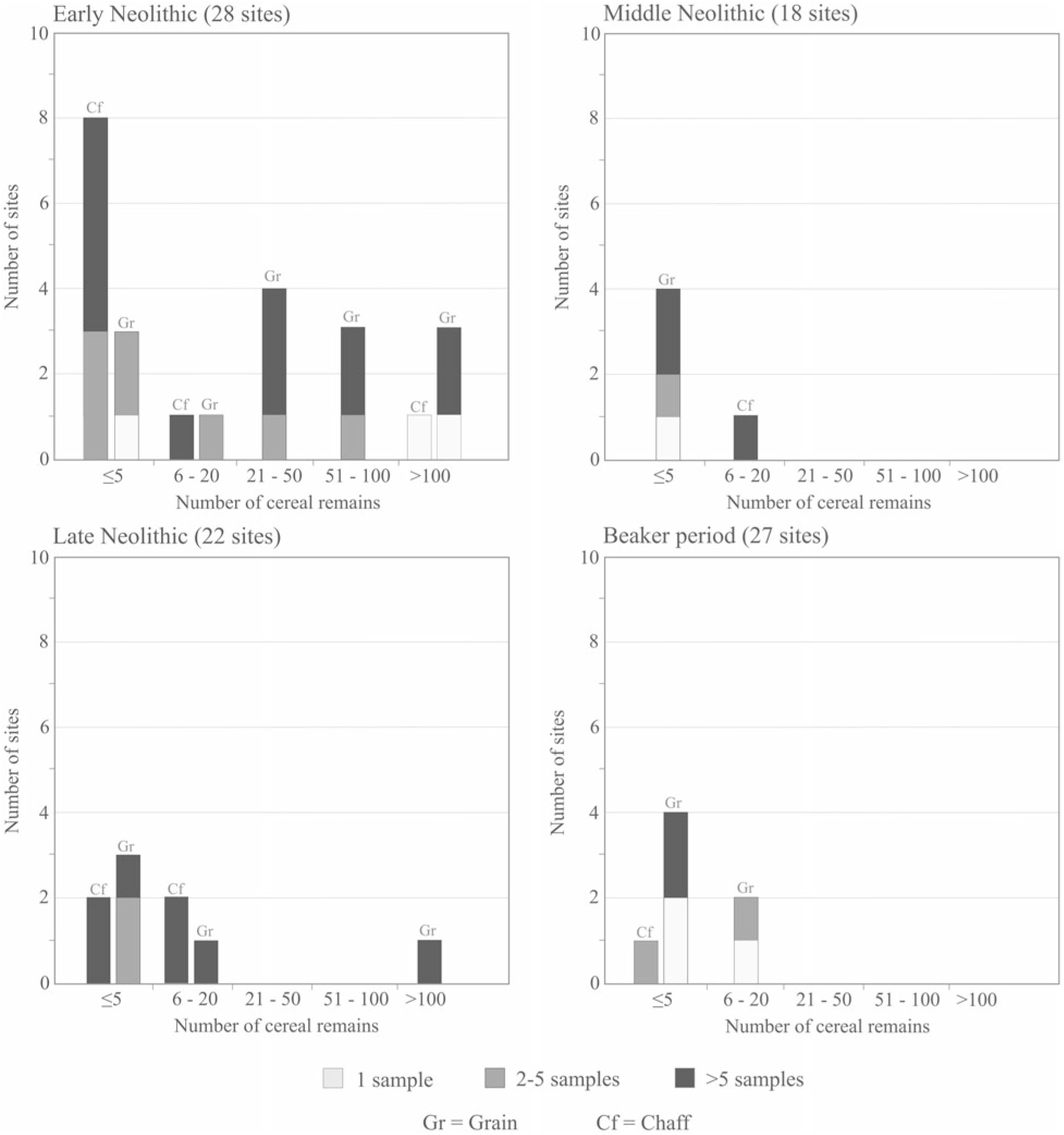
Fig. 7. Quantity of cereal remains (grains, chaff) recovered for each period displayed in relation to the number of samples taken. Number of sites (in parentheses) refers to the total number of sites for each period
Sampling strategies influenced the recovery of cereals. Grains and chaff occurred more frequently and in larger quantities at sites where larger numbers of samples were analysed. This is particularly apparent for the Early Neolithic period: larger assemblages of cereal grain and chaff were more frequently recorded at sites with >5 samples.
Cereal-rich sites
Large assemblages of cereals (>100 remains) were recorded at three Early and one Late Neolithic site. This data is summarised in Table 5. Large grain assemblages dating to the Early Neolithic have all been recovered from pits: Pen-y-Crug (Site 9: Rackham Reference Rackham, Barber and Hart2014), Cwmifor (Site 13: Rackham Reference Rackham, Barber and Hart2014), and Plas Gogerddan (Site 26: Caseldine Reference Caseldine and Murphy1992). At Cwmifor (Site 13: Rackham Reference Rackham, Barber and Hart2014), 75% of the cereal grain assemblage (204 grains) was recovered from one pit (1/11 samples), whilst at Pen-y-Crug (Site 9: Rackham Reference Rackham, Barber and Hart2014), 90% of the grains (513 grains) were recovered from two pits (2/8 samples). At both sites, emmer wheat was the dominant cereal type and chaff was rare. The pit at Plas Gogerddan (Site 26: Caseldine Reference Caseldine and Murphy1992) produced a rich assemblage of emmer wheat grains and chaff, occasional barley grains and one weed seed.Footnote 1 The chaff primarily consisted of emmer wheat glume bases and spikelet forks, though rachis fragments and basal internodes were also recorded. The abundant chaff remains may be due to storage in the spikelet form (Caseldine Reference Caseldine and Murphy1992). At all these sites, cereal-rich contexts also produced abundant wild plant remains.
TABLE 5: SUMMARY OF DATA FROM CEREAL-RICH (>100 CEREAL REMAINS)

a estimated sample volume; b archaeobotanical data presented in original report differs slightly fro the published summary (1 sample has also been excluded); see also endnote 2
Only one Late Neolithic site, Capel Eithin (Site 11: Williams Reference Williams, White and Smith1999), produced a large cereal assemblage. In total, 457 cerealsFootnote 2 were recovered from four pits (excluding a sample with probable intrusive remains). Most cereals (91%) were recovered from two pits and the assemblage is dominated by barley, primarily naked barley. Unfortunately, direct AMS radiocarbon dating of cereals has not been undertaken for this assemblage.
Potential arable weeds
Analysing the dataset on a context-by-context basis (Table 6), indicates that weed seeds accompanying ≥10 cereal remains were only identified at five Early Neolithic sites (9 contexts), one Middle Neolithic site (1 context) and one Late Neolithic site (3 contexts). Further data is provided in Table S3. In nearly all cases, the quantity of weed seeds present was very small and most species were recorded in only one site. The species recorded can grow in a range of habitats (disturbed, grassland, freshwater/moorland, woodland edge), though disturbed ground and grassland taxa dominate the assemblages and both annual and perennial species are present. Due to the small quantity of cereal remains it is not possible to reliably interpret cereal cultivation practices from the weed seed data.
TABLE 6: POTENTIAL ARABLE WEEDS RECORDED IN CONTEXTS CONTAINING ≥10 CEREAL GRAINS/CHAFF REMAINS
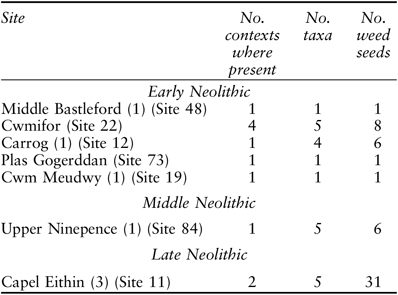
Stable carbon (δ13C) and nitrogen (δ15N) isotope analysis of Early Neolithic cereal grains
Mean δ13C and δ15N values for each site are presented in Table 7 and individually for each sample in Figure 8. Table S5 includes δ13C, δ15N, C/N atomic ratio, %C, and % N results for each sample. Due to potential variability in stable isotope measurements in cereals cultivated under the same conditions and within single cereal ears (Bogaard et al. Reference Bogaard, Heaton, Poulton and Merbach2007; Nitsch et al. Reference Nitsch, Charles and Bogaard2014) it is not possible to assess reliably differences in cereal δ13C and δ15N values between sites because of the small sample size.
TABLE 7: CEREAL GRAIN NITROGEN (δ15N) AND CARBON (δ13C) ISOTOPE RESULTS FROM EARLY NEOLITHIC SITES IN WALES

* Numbers in parenthesis are the mean and associated standard deviation
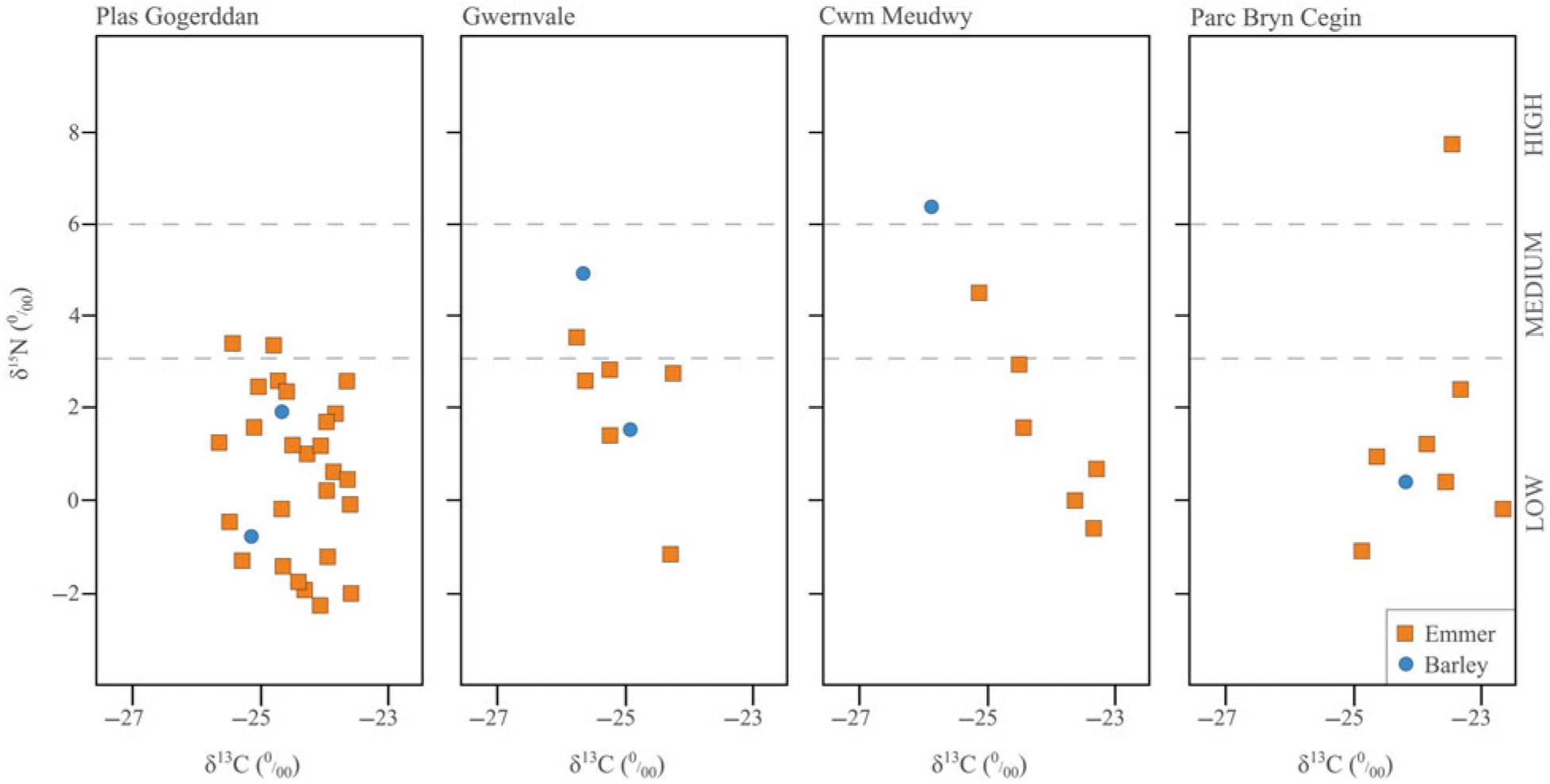
Fig. 8. Cereal carbon (δ13C) and nitrogen (δ15N) isotope results from Early Neolithic sites in Wales: Plas Gogerddan (Site 73), Gwernvale (Site 33), Cwm Meudwy (Site 19), & Parc Bryn Cegin (Site 57). Manuring levels follow Bogaard et al. (Reference Bogaard, Fraser, Heaton, Wallace, Vaiglova, Charles, Jones, Evershed, Styring, Andersen and Arbogast2013): ‘none or low’ (<3‰ δ15N), ‘medium’ (3–6‰ δ15N) and ‘high’ (>6‰ δ15N)
Mean δ13C values for emmer wheat were –24.4±0.7‰ and for barley were –25.0±0.6‰ and fall within the expected range for crops growing in good water availability (Wallace et al. Reference Wallace, Jones, Charles, Fraser, Halstead, Heaton and Bogaard2013). The lower δ13C values of barley compared to wheat have been observed in previous studies probably due to a physiological difference between wheat and barley (eg, Ferrio et al. Reference Ferrio, Araus, Buxó, Voltas and Bort2005; Wallace et al. Reference Wallace, Jones, Charles, Fraser, Halstead, Heaton and Bogaard2013). Barley mean δ15N values were 2.5±2.9‰ and emmer wheat mean δ15N values were 0.9±1.7‰ (excluding possible outlier sample, NCI 047). Emmer wheat δ15N values varied widely from –2.2‰ to 4.5‰, however, 40/44 (91%) samples fall within the range expected for low or no manuring (ie, <3‰, following Bogaard et al. Reference Bogaard, Fraser, Heaton, Wallace, Vaiglova, Charles, Jones, Evershed, Styring, Andersen and Arbogast2013). Nearly all the samples from Plas Gogerddan fall in the low or no manuring band. Insufficient data is available to compare barley and emmer wheat δ15N values.
DISCUSSION
A substantial quantity of archaeobotanical data now exists for Neolithic Wales which can be largely attributed to developer-funded archaeological projects. This provides a valuable comparison to published evidence from Ireland (McClatchie et al. Reference McClatchie, Bogaard, Colledge, Whitehouse, Schulting, Barratt and McLaughlin2014) and other parts of Britain (Jones & Rowley-Conwy Reference Jones and Rowley-Conwy2007; Bishop et al. Reference Bishop, Church and Rowley-Conwy2009; Pelling & Campbell Reference Pelling, Campbell, Canti, Campbell and Gearey2013) as well as continental Europe (eg, Colledge & Conolly Reference Colledge and Conolly2007; Salavert Reference Salavert2011; Kirleis et al. Reference Kirleis, Klooß, Kroll and Müller2012; Kirleis & Fischer Reference Kirleis and Fischer2014; Sørensen & Karg Reference Sørensen and Karg2014). The archaeobotanical evidence does not provide evidence for migration or acculturation per se, however, it contributes to wider debates surrounding the Mesolithic–Neolithic transition including wild plant use, the introduction and significance of cereals, the nature of farming regimes, and later Neolithic decline in cereal cultivation.
Wild plant use: systematic and intensive?
There is considerable evidence for the use of wild plants in the Early Neolithic: primarily hazelnuts alongside rarer evidence for other edible fruits and nuts. Excluding hazelnuts, the most commonly represented wild plants in Early Neolithic contexts are raspberry/blackberry and crab apple, though hawthorn, sloe, and acorn were also recorded. Crab apple (both seeds and fruit fragments) were more commonly recorded in Early Neolithic sites than in later periods and a large assemblage was recovered from Plas Gogerddan (Site 73: Caseldine Reference Caseldine and Murphy1992). This range of wild species is comparable to later Mesolithic archaeobotanical assemblages in Wales (eg, Caseldine Reference Caseldine and Bell2000; Dark Reference Dark and Bell2007; Brown Reference Brown and Bell2007a; McKenna Reference McKenna, Smith and Walker2014). For the later Neolithic and Beaker periods, evidence for wild plants is also dominated by hazel nutshell and other wild fruits and nuts occur less frequently, though a diverse range of species was recorded. This includes raspberry/blackberry, crab apple, acorn, indeterminate Prunus, sloe, hawthorn, elder, rose (Rosaceae sp.) and parenchyma fragments which could be remains of fruits/tubers. Evidence for these wild fruits/nuts was often restricted to a single site and represented by a small number of identifications.
Hazelnut, crab apple and probably raspberry/blackberry are best interpreted as deliberately gathered foods, however, in the case of other wild fruits and nuts it is possible that these remains were incorporated into fires unintentionally and are not deliberately gathered. In Early and later Neolithic assemblages in Britain and Ireland, as well as in central and northern European assemblages, hazelnut, raspberry/blackberry, sloe, and crab apple are amongst the most commonly recorded wild plants, whilst other fruits and nuts are often rarer (Jones & Rowley-Conwy Reference Jones and Rowley-Conwy2007; Bishop et al. Reference Bishop, Church and Rowley-Conwy2009; Campbell & Pelling 2013; McClatchie et al. Reference McClatchie, Bogaard, Colledge, Whitehouse, Schulting, Barratt and McLaughlin2014; for central and northern Europe see Colledge & Conolly Reference Colledge and Conolly2007; Reference Colledge and Conolly2014). However, whilst acorn is commonly recorded in continental European charred/waterlogged assemblages (Deforce et al. Reference Deforce, Bastiaens, van Neer, Ervynck, Lentacker, Sergant and Crombé2013), it is absent in Ireland (McClatchie et al. Reference McClatchie, Bogaard, Colledge, Whitehouse, Schulting, Barratt and McLaughlin2014) and Scotland (Bishop et al. Reference Bishop, Church and Rowley-Conwy2009) and is only recorded at one site in England (Cobain Reference Cobain, Hart, Wood, Barber, Brett and Hardy2014). The occurrence of acorn at five sites in Wales (1 Early Neolithic, 3 later Neolithic, 1 Beaker period) is unusual, though it is possible that these remains were not deliberately gathered. The rarity of acorns may reflect a preservation bias, or rather that acorn was not widely exploited as a food resource (Pelling & Campbell Reference Pelling, Campbell, Canti, Campbell and Gearey2013). Other wild plants may be arable weeds, though plants such as bindweed, recorded at Cwmifor (Site 22: Rackham Reference Rackham, Barber and Hart2014), and sheep’s sorrel, recorded at Carrog (Site 12: Caseldine et al. Reference Caseldine, Griffiths, Peck and Smith2014), could also have been deliberately gathered as foods (Behre Reference Behre2008; Pelling & Campbell Reference Pelling, Campbell, Canti, Campbell and Gearey2013).
The range of wild plant species recorded probably reflects species which have a higher probability of becoming charred and preserving (Jacomet Reference Jacomet2007). For instance, some plants are unlikely to become charred and are difficult to identify (eg, roots, tubers, fruits, leafy vegetables: Zvelebil Reference Zvelebil1994; Kubiak-Martens Reference Kubiak-Martens2002; Hather & Mason Reference Hather, Mason, Hather and Mason2002; Colledge & Conolly Reference Colledge and Conolly2014). Tubers are rarely recorded in British Neolithic assemblages (eg, Straker Reference Straker and Saville1990; Fairbairn Reference Fairbairn, Whittle, Davies, Dennis, Fairbairn and Hamilton2000; Wilkinson et al. Reference Wilkinson, Murphy, Brown and Heppell2012). In contrast, hazel nutshell is viewed as over-represented as it has a high probability of becoming charred, either deliberately or accidentally, and preserving (Legge Reference Legge, Milles, Willimans and Gardiner1989; Jones Reference Jones and Fairbairn2000; Jones & Rowley-Conwy Reference Jones and Rowley-Conwy2007; Bishop et al. Reference Bishop, Church and Rowley-Conwy2009; Bishop Reference Bishop2019). Similarly, crab apple and sloe may have been dried, increasing the possibility of charring (Kohler-Schneider Reference Kohler-Schneider2007; Bishop et al. Reference Bishop, Church and Rowley-Conwy2009; Reference Bishop, Church and Rowley-Conwy2014). Raspberry/blackberry are light-demanding and are likely to have colonised woodland edges around sites (Colledge & Conolly Reference Colledge and Conolly2014), increasing the probably of charring (eg, vegetation burning or incidental inclusion in hearths). Hazelnut, hawthorn, elder, sloe, and rose are also likely to have been common in woodland edges (Colledge & Conolly Reference Colledge and Conolly2014). Blackberry/raspberry and elder seeds are also thought to be particularly resistant to decay (Moffett in Hedges et al. Reference Hedges, Housley, Bronk Ramsey and van Klinken1993; Dark Reference Dark and Bell2007; Carruthers in Rackham Reference Rackham and Hart2013a), making them more likely to persist in the soil around sites which would also increase the probability of charring (for instance, below hearths: Sievers & Wadley Reference Sievers and Wadley2008). However, it is important to emphasise that some wild plants may have become charred unintentionally and were not deliberately gathered.
Waterlogged assemblages may provide a more representative picture of Neolithic wild plant use (Colledge & Conolly Reference Colledge and Conolly2014; Antolín & Jacomet Reference Antolín and Jacomet2015). A single waterlogged assemblage is available for Wales at Llandevenny (Site 40) that produced abundant remains of raspberry/blackberry and nettle alongside other wild plants, including some charred material (Brown Reference Brown and Bell2007a). However, it is unclear if the plant remains were deliberately gathered or incorporated into fires unintentionally (for instance, vegetation burning: Brown Reference Brown and Bell2007a; cf. Cappers Reference Cappers1993; Sievers & Wadley Reference Sievers and Wadley2008; Out Reference Out2012). In the wider European context, the significance of wild plants is thought to be considerably under-represented in Neolithic charred archaeobotanical assemblages, though waterlogged assemblages hint at the potentially diverse range of wild plants which could have been exploited (Pelling & Campbell Reference Pelling, Campbell, Canti, Campbell and Gearey2013; Thomas Reference Thomas2014; Colledge & Conolly Reference Colledge and Conolly2014).
Ethnographic studies highlight the potential role of hunter-gatherers and farmers in actively modifying environments to promote the growth of certain plants/wood species to increase their productivity for food or to facilitate hunting (Smith Reference Smith2011; Rowley-Conwy & Layton Reference Rowley-Conwy and Layton2011). There is growing recognition that wild plants and woodlands may have been managed or altered in the European Mesolithic and Neolithic (Schulting Reference Schulting and Pollard2008; Jackson & Ray Reference Jackson and Ray2012; Kirleis et al. Reference Kirleis, Klooß, Kroll and Müller2012; Colledge & Connolly Reference Colledge and Conolly2014; Barrett Reference Barrett, Whittle and Bickle2014; Antolín & Jacomet Reference Antolín and Jacomet2015; Bishop et al. Reference Bishop, Church and Rowley-Conwy2014; Reference Bishop, Church and Rowley-Conwy2015; Warren et al. Reference Warren, Davis, McClatchie and Sands2014; Jacomet et al. Reference Jacomet, Ebersbach, Akeret, Antolín, Baum, Bogaard, Brombacher, Bleicher, Heitz-Weniger, Hüster-Plogmann and Gross2016). A challenge is identifying how wild plants and woodlands were exploited using archaeobotanical evidence (Bishop et al. Reference Bishop, Church and Rowley-Conwy2014; Warren et al. Reference Warren, Davis, McClatchie and Sands2014).
Though hazelnuts are probably over-represented in relative terms, the ubiquity and abundance of hazel nutshell may indicate large-scale and systematic exploitation of hazel (cf. Zvelebil Reference Zvelebil1994). In addition, since hazelnuts are only available for a short time period in autumn, it is probable that they were stored (Bishop et al. Reference Bishop, Church and Rowley-Conwy2014). Crab apples may also have been dried for storage (Caseldine Reference Caseldine and Murphy1992; Kohler-Schneider Reference Kohler-Schneider2007; Jacomet Reference Jacomet2007; Bishop et al. Reference Bishop, Church and Rowley-Conwy2014). There is some evidence to indicate the deliberate manipulation of environments to promote the growth of specific plants in the Late Mesolithic and Early Neolithic in the Severn Estuary, south-east Wales (Bell Reference Bell and Bell2007b). It remains a possibility that there was a degree of deliberate manipulation or management of woodlands to promote the growth of hazel alongside other light-demanding species such as crab apple, sloe, and raspberry/blackberry (Colledge & Conolly Reference Colledge and Conolly2014). Therefore, the introduction of cereal cultivation should be placed within the context of a ‘wild’ landscape which was perhaps already being manipulated or managed to some degree, blurring the traditional dichotomy between ‘hunter-gathering’ and ‘farming’ (Barrett Reference Barrett, Whittle and Bickle2014).
Early Neolithic: The introduction of cereals
The introduction and uptake of cereals in Wales (c. 3700 cal bc) appears to have been geographically widespread. Cereals were recorded at 57% of sites (16 sites), however, if sites where plant remains were absent altogether are excluded (5 sites), then the number with cereals increases to 70%. Cereals were primarily recorded at pits/pit groups and rectangular structures/houses, including midden deposits at Gwernvale (Site 33: Caseldine in prep.), reflecting sites with good evidence for occupation deposits. Scant evidence for cereals (not directly dated) was recorded in a shell midden at Nant Hall Road (Site 52: Caseldine Reference Caseldine, Armour-Chelu, Bell, Brayshay, Britnell, Cameron, Caseldine, Dresser, Francourt, Gonzalez, Healy, Johnson, Norris-Hill, Schulting and Thomas2007) and a causewayed enclosure at Womaston (Site 94: Jones Reference Jones2009). However, the dataset is biased towards pits/pit groups as few rectangular structures/houses, funerary, and monumental sites have been excavated recently and sampled for plant remains.
Wheat was the dominant crop-type, most likely emmer wheat, though barley is commonly recorded and evidence for other cereals (naked wheat, oat) is very limited. Where barley was present, it is likely that the naked variety was dominant (cf. Pelling & Campbell Reference Pelling, Campbell, Canti, Campbell and Gearey2013). Oat may have been a weed, though it is unclear if these remains are intrusive (oat was widely cultivated in later periods:. Schmidl et al. Reference Schmidl, Carrott, Jaques and Kenney2008; McKenna Reference McKenna, Kenney and Parry2013; cf. McClatchie et al. Reference McClatchie, Bogaard, Colledge, Whitehouse, Schulting, Barratt and McLaughlin2016). The status of naked wheat as a crop is unclear since it is commonly intrusive in British Neolithic contexts (Pelling et al. Reference Pelling, Campbell, Carruthers, Hunter and Marshall2015). There is no unequivocal evidence for einkorn wheat (Triticum monococcum L.) and no evidence for oil crops (flax, poppy – Papaver sp.) or pulses (Celtic bean, pea – Pisum sativum L.) in the Early Neolithic.
The range of cereal-types recorded in Early Neolithic Wales is comparable to other evidence from central/southern Britain and Ireland where emmer wheat is the main crop, whilst einkorn is very rare (Straker Reference Straker and Saville1990; Jackson & Ray Reference Jackson and Ray2012; Jones & Rowley-Conwy Reference Jones and Rowley-Conwy2007; Bishop et al. Reference Bishop, Church and Rowley-Conwy2009; Pelling & Campbell Reference Pelling, Campbell, Canti, Campbell and Gearey2013; McClatchie et al. Reference McClatchie, Bogaard, Colledge, Whitehouse, Schulting, Barratt and McLaughlin2014). Barley, primarily naked barley, is frequently recorded in Britain and Ireland though it appears to have been of secondary importance to emmer wheat (Pelling & Campbell Reference Pelling, Campbell, Canti, Campbell and Gearey2013; McClatchie et al. Reference McClatchie, Bogaard, Colledge, Whitehouse, Schulting, Barratt and McLaughlin2014), except in areas of Scotland (Bishop et al. Reference Bishop, Church and Rowley-Conwy2009). Naked wheat grains are common, though typically a minor component of assemblages and in many cases are intrusive (Pelling & Campbell Reference Pelling, Campbell, Canti, Campbell and Gearey2013; Pelling et al. Reference Pelling, Campbell, Carruthers, Hunter and Marshall2015). Other crops are recorded sporadically including flax and poppy (Jones & Rowley-Conwy Reference Jones and Rowley-Conwy2007; Campbell & Robinson Reference Campbell, Robinson, Harding and Healy2007), whilst pulse crops (pea, Celtic bean) appear absent (Treasure & Church Reference Treasure and Church2017). The range of cereal types present contrasts with central and northern European sites where einkorn is commonly recorded and naked wheat also appears to have been a more important crop (eg, Kreuz Reference Kreuz2007; Salavert Reference Salavert2011; Kirleis et al. Reference Kirleis, Klooß, Kroll and Müller2012; Kirleis & Fischer Reference Kirleis and Fischer2014). Overall, it is apparent that there was a substantial degree of uniformity, rather than regional diversity, in Early Neolithic archaeobotanical assemblages in both the cereal-types and wild plants recorded across most of Britain and Ireland.
The widespread uptake of cereals in Early Neolithic Wales does not provide evidence for migration per se, however, it is perhaps more consistent with models of the Neolithic transition which prioritise the migration of farmers (eg, Rowley-Conwy 2004; Reference Rowley-Conwy2011; Sheridan Reference Sheridan, Finlayson and Warren2010; Stevens & Fuller Reference Stevens and Fuller2012). Despite this, indigenous hunter-gatherers probably adopted and diffused cereals to some extent, possibly cultivating cereals or acquiring them via exchange (eg, Thomas Reference Thomas2014). To address this in more detail, direct AMS radiocarbon dating of cereals from sites in Wales is required to assess the timing of their introduction and its relationship to wider changes in the archaeological record (Griffiths Reference Griffiths2018). Other lines of evidence provide compelling evidence for migration in this period including strontium isotope analyses of Early Neolithic human remains in south-east Wales (Neil et al. Reference Neil, Montgomery, Evans, Cook and Scarre2017) and large-scale aDNA studies (Brace et al. Reference Brace2019). A sharp demographic increase coeval with the introduction of farming in Britain and Ireland is also indicated (Stevens & Fuller Reference Stevens and Fuller2012; McLaughlin et al. Reference McLaughlin, Whitehouse, Schulting, McClatchie, Barratt and Bogaard2016), possibly during a period of warming climate (Warden et al. Reference Warden, Moros, Neumann, Shennan, Timpson, Manning, Sollai, Wacker, Perner, Häusler and Leipe2017; cf. Dark & Gent Reference Dark and Gent2001). Wider changes in subsistence practices are also present, with indications of a shift in diets away from marine resources (Schulting et al. Reference Schulting, Fibiger, Macphail, McLaughlin, Murray, Price and Walker2013).
Early Neolithic: the significance of cereals in subsistence practices
Cereals were typically present in low-densities and cereal-rich contexts are uncommon (ie, >100 grains/chaff remains). The low-density of cereals in Early Neolithic sites is typical of British and Irish assemblages, as well as central European LBK and northern European TRB assemblages (Bogaard & Jones Reference Bogaard, Jones, Whittle and Cummings2007; Jones & Rowley-Conwy Reference Jones and Rowley-Conwy2007; Kreuz Reference Kreuz2007; Robinson Reference Robinson2007; Bishop et al. Reference Bishop, Church and Rowley-Conwy2009; Salavert Reference Salavert2011; Kirleis et al. Reference Kirleis, Klooß, Kroll and Müller2012; McClatchie et al. Reference McClatchie, Bogaard, Colledge, Whitehouse, Schulting, Barratt and McLaughlin2014). This is likely to reflect a combination of taphonomic factors and the scale of cereal production. For instance, cereals are unlikely to become charred, unless accidentally burnt (Jones & Rowley-Conwy Reference Jones and Rowley-Conwy2007) and are likely to be under-represented at sites where only limited sampling was undertaken, as is the case for most Early Neolithic sites in Wales (Jones Reference Jones and Fairbairn2000; Jones & Rowley-Conwy Reference Jones and Rowley-Conwy2007; Jones & Legge Reference Jones, Legge, Mercer and Healy2008; Bishop et al. Reference Bishop, Church and Rowley-Conwy2009; McClatchie et al. Reference McClatchie, Bogaard, Colledge, Whitehouse, Schulting, Barratt and McLaughlin2014). Equally, there is an ‘element of chance’ in the recovery of cereal-rich assemblages, necessitating large-scale sampling (Jones Reference Jones and Fairbairn2000; Pelling & Campbell Reference Pelling, Campbell, Canti, Campbell and Gearey2013). Considering these taphonomic factors, the important point here is that cereals occur consistently, suggesting that cereals were an important component of subsistence practices (Stevens Reference Stevens2007; Jones & Rowley-Conwy Reference Jones and Rowley-Conwy2007; McClatchie et al. Reference McClatchie, Bogaard, Colledge, Whitehouse, Schulting, Barratt and McLaughlin2016). Variability in the quantity of cereal remains recovered may reflect local/regional variations (Bishop Reference Bishop2015), though disentangling the impact of taphonomic factors is difficult.
Whilst cereal grains are widely present across Early Neolithic Wales, chaff and weed seeds are remarkably rare. This is typical of Early Neolithic assemblages in Britain, Ireland, and southern Scandinavia, though it presents a marked contrast to LBK assemblages (Robinson Reference Robinson and Fairbairn2000; Colledge et al. Reference Colledge, Conolly and Shennan2005; Kreuz Reference Kreuz2007; Stevens Reference Stevens2007; Bogaard & Jones Reference Bogaard, Jones, Whittle and Cummings2007; Bishop et al. Reference Bishop, Church and Rowley-Conwy2009; see also Robinson Reference Robinson2007 and Sørensen & Karg Reference Sørensen and Karg2014). The rarity of chaff may reflect several factors, for example dehusking of emmer wheat by pounding or rubbing, rather than parching (Robinson Reference Robinson and Fairbairn2000, 88), or off-site crop processing which reduces the risk of accidental charring or storage of clean grain (Robinson Reference Robinson and Fairbairn2000; Kreuz Reference Kreuz2007; Stevens Reference Stevens2007; Jones & Rowley-Conwy Reference Jones and Rowley-Conwy2007; Bogaard & Jones Reference Bogaard, Jones, Whittle and Cummings2007; Bishop et al. Reference Bishop, Church and Rowley-Conwy2009). Storing clean grain is interesting as the resulting crop is more portable and this could have some connection with the degree of residential mobility as well as the exchange/movement of cereals (Stevens Reference Stevens2007; Thomas Reference Thomas2014). The by-products of cereal processing are viewed as characteristic markers of local cultivation and it is often assumed, rather than proven, that cereals recovered from Neolithic sites were locally cultivated (cf. Hillman Reference Hillman and Britnell1982). The movement and/or exchange of cereals is a factor which requires further attention (Deforce et al. Reference Deforce, Bastiaens, van Neer, Ervynck, Lentacker, Sergant and Crombé2013; cf. Bishop Reference Bishop2015; Meylemans et al. Reference Meylemans, Bastiaens, Boudin, Defore, Ervynck, Perdaen, Sergant, Storme and Crombé2018).
Early Neolithic: Assessing cereal cultivation practices through weed ecology and cereal isotope measurements
Considerable research has focused on identifying the introduction of cereals; however, less attention has been directed towards understanding the nature of early farming practices (Bogaard Reference Bogaard2005). In part, this reflects the rarity of weed seeds in Neolithic assemblages (Bogaard Reference Bogaard, Whittle and Bickle2014; Stevens & Fuller Reference Stevens, Fuller, Lightfoot, Liu and Fuller2018). This rarity potentially reflects harvesting techniques (ie, gathering of cereal ears), crop-processing methods (ie, careful crop cleaning), or cultivation practices (Colledge et al. Reference Colledge, Conolly and Shennan2005; Jacomet et al. Reference Jacomet, Ebersbach, Akeret, Antolín, Baum, Bogaard, Brombacher, Bleicher, Heitz-Weniger, Hüster-Plogmann and Gross2016; Stevens & Fuller Reference Stevens, Fuller, Lightfoot, Liu and Fuller2018). Slash-and-burn cultivation regimes may account for the rarity of weed seeds (Robinson Reference Robinson2007; Rösch et al. Reference Rösch, Kleinmann, Lechterbeck and Wick2014; Reference Rösch, Biester, Bogenrieder, Eckmeier, Ehrmann, Gerlach, Hall, Hartkopf-Fröder, Herrmann, Kury and Lechterbeck2017), however, the evidence for this is equivocal since weeds may be rare for several years in plots recently cleared of trees (Halstead Reference Halstead2018).
The few weed seeds present in Neolithic Wales do not permit detailed interpretations of crop cultivation practices. Species recorded include annuals and perennials which can grow in a range of habitats, though taxa of disturbed and grassland habitats were dominant, and this is typical of assemblages in Britain and Ireland (Bogaard & Jones Reference Bogaard, Jones, Whittle and Cummings2007; Pelling & Campbell Reference Pelling, Campbell, Canti, Campbell and Gearey2013; McClatchie et al. Reference McClatchie, Bogaard, Colledge, Whitehouse, Schulting, Barratt and McLaughlin2014). Though the dataset is very limited, evidence for perennial species typical of woodland habitats was minimal, as would be expected under a shifting cultivation regime (cf. Bogaard Reference Bogaard2002). Analyses of potential arable weeds in Britain and Ireland also suggests that cereals were cultivated in long-lived (>10 years) plots (Bogaard & Jones Reference Bogaard, Jones, Whittle and Cummings2007; McClatchie et al. Reference McClatchie, Bogaard, Colledge, Whitehouse, Schulting, Barratt and McLaughlin2014), however the dataset for Wales is too small to investigate this.
Stable isotope analyses of cereals can be used to investigate directly cultivation conditions of specific cereal-types, independently of weed seed data (Bogaard Reference Bogaard, Whittle and Bickle2014). In particular, cereal δ15N values have been used to identify manuring in Neolithic Europe, however, samples have only been analysed from a small number of Early Neolithic sites (Bogaard et al. Reference Bogaard, Fraser, Heaton, Wallace, Vaiglova, Charles, Jones, Evershed, Styring, Andersen and Arbogast2013; Kanstrup et al. Reference Kanstrup, Holst, Jensen, Thomsen and Christensen2014; Styring et al. Reference Styring, Maier, Stephan, Schlichtherle and Bogaard2016; Reference Styring, Rösch, Stephan, Stika, Fischer, Sillmann and Bogaard2017; Gron et al. Reference Gron, Gröcke, Larsson, Sørensen, Larsson, Rowley-Conwy and Church2017). The cereal isotope measurements for Early Neolithic Wales provide an important contribution to this dataset. Though the sample size is small, at the time of analysis it represented the best available material. This approach is valuable when small samples of cereal grains from several sites are combined, particularly considering the lack of well-preserved cereal assemblages.
Cereal δ15N values for Early Neolithic Wales largely fall within the ‘no manuring or low manuring’ range. Short-term manuring (ie, 1–2 years) cannot be excluded since this has a less significant and more variable impact on δ15N values (Fraser et al. Reference Fraser, Bogaard, Heaton, Charles, Jones, Christensen, Halstead, Merbach, Poulton, Sparkes and Styring2011). In addition, there is some evidence for the cultivation of ‘middens’ in Early Neolithic Wales (Nant Hall Road, Site 52: Bell Reference Bell and Bell2007b) and elsewhere in southern Britain (Guttmann Reference Guttmann2005). The impact of midden cultivation on cereal δ15N values is unclear, however, it is likely to elevate cereal δ15N values. Despite this, the cereal isotope results suggest that long-term, intensive manuring was not undertaken at the sites analysed. Cereals may have been cultivated in low-intensity regimes on poor soils, assuming they were locally cultivated. This evidence contrasts with currently published data from Early Neolithic sites in Europe.
To analyse the earliest farming practices in Neolithic Europe, Figure 9 compares the results for Early Neolithic Wales with evidence from Early Neolithic sites in England, southern Scandinavia, and south-western Germany. In England, ‘high’ δ15 N values were recorded in a rectangular structure/house at Lismore Fields, Derbyshire (c. 3810–3600 cal bc) suggesting long-term intensive manuring (Jones & Bogaard Reference Jones, Bogaard, Rowley-Conwy, Serjeantson and Halstead2017), whilst slightly lower δ15N values from a causewayed enclosure at Hambledon Hill, Dorset (c. 3700–3300 cal bc) may indicate less intensive/shorter-term manuring (Bogaard et al. Reference Bogaard, Fraser, Heaton, Wallace, Vaiglova, Charles, Jones, Evershed, Styring, Andersen and Arbogast2013; Jones & Bogaard Reference Jones, Bogaard, Rowley-Conwy, Serjeantson and Halstead2017). At Stensborg (c. 3700–3360 cal bc), southern Scandinavia, Gron et al. (Reference Gron, Gröcke, Larsson, Sørensen, Larsson, Rowley-Conwy and Church2017) identified evidence for long-term intensive manuring, though variation is present and δ15N values range from ‘low’ to ‘high’, with emmer wheat and naked wheat more intensively manured than barley. Evidence for intensive manuring was also identified at LBK Vaihingen (c. 5500–5070 cal bc) and Viesenhäuser Hof (c. 5500–4000 cal bc, data not presented in Fig. 9), south-western Germany (Bogaard et al. Reference Bogaard, Fraser, Heaton, Wallace, Vaiglova, Charles, Jones, Evershed, Styring, Andersen and Arbogast2013; Styring et al. Reference Styring, Rösch, Stephan, Stika, Fischer, Sillmann and Bogaard2017).
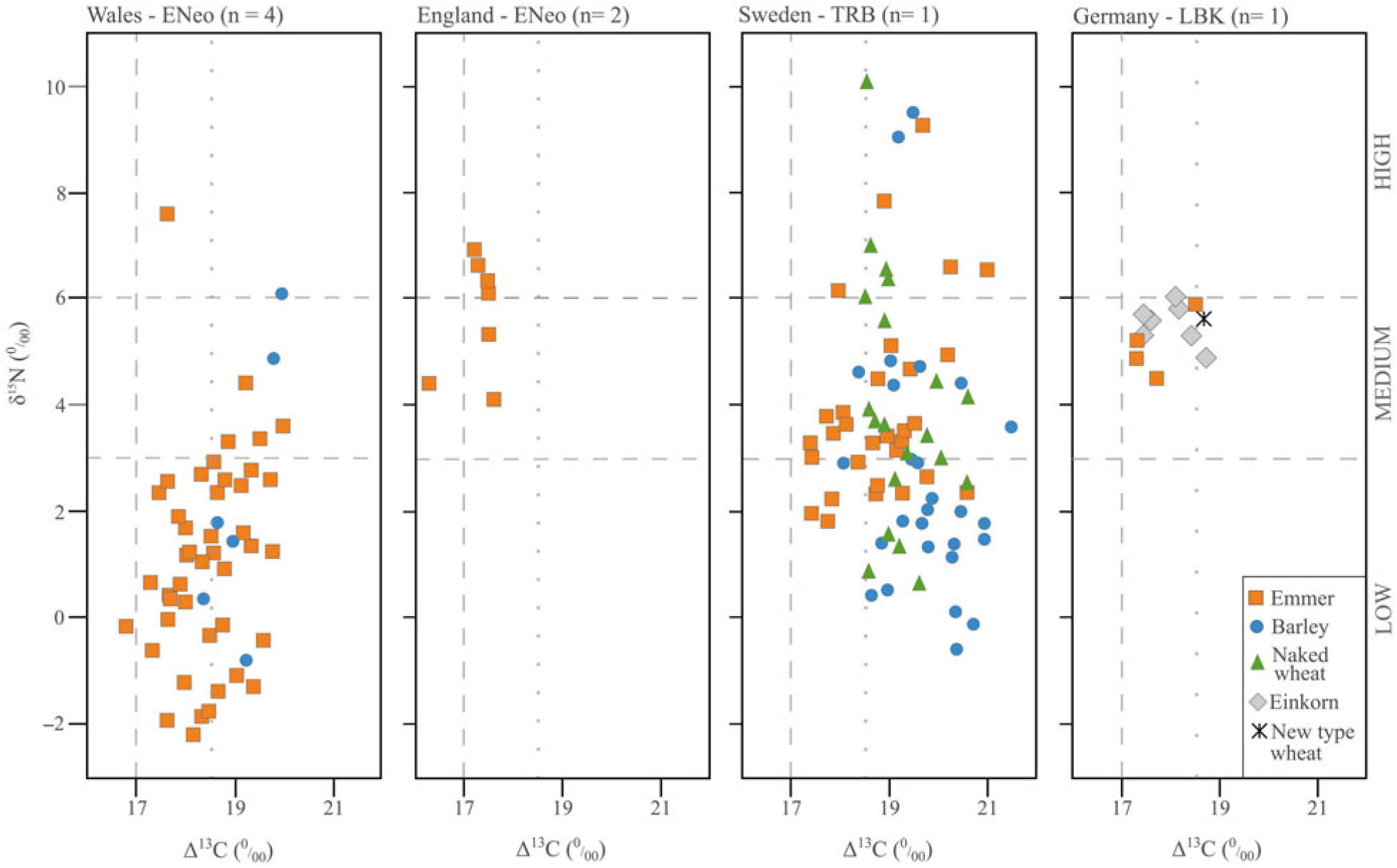
Fig. 9. Cereal grain carbon (Δ13C) and nitrogen (δ15N) results for Early Neolithic Wales compared with Early Neolithic data from England, Sweden, & Germany. Note that cereal Δ13C values are presented (opposed to δ13C values) to enable comparison between sites of different periods. Manuring levels follow Bogaard et al. (Reference Bogaard, Fraser, Heaton, Wallace, Vaiglova, Charles, Jones, Evershed, Styring, Andersen and Arbogast2013): ‘none or low’ (<3‰ δ15N), ‘medium’ (3–6‰ δ15N) and ‘high’ (>6‰ δ15N). The vertical dashed line represents well-watered wheat (17‰ Δ13C) and the vertical dotted line represents well-watered barley (18.5‰ Δ13C), based on Wallace et al. (Reference Wallace, Jones, Charles, Fraser, Halstead, Heaton and Bogaard2013). The cereal data for Wales (this paper) and Sweden (Gron et al. Reference Gron, Gröcke, Larsson, Sørensen, Larsson, Rowley-Conwy and Church2017) are based on single entity samples, whereas the data from England and Germany (Bogaard et al. Reference Bogaard, Fraser, Heaton, Wallace, Vaiglova, Charles, Jones, Evershed, Styring, Andersen and Arbogast2013) are bulk samples
The evidence from Early Neolithic Wales contrasts with this general pattern of intensive manuring recorded at other European Early Neolithic sites, though variability is present. For instance, samples within the ‘low’ to ‘no manuring’ range were identified at Stensborg (Gron et al. Reference Gron, Gröcke, Larsson, Sørensen, Larsson, Rowley-Conwy and Church2017), as well as in the later site of Sarup (3400–2900 cal bc) southern Scandinavia (Bogaard et al. Reference Bogaard, Fraser, Heaton, Wallace, Vaiglova, Charles, Jones, Evershed, Styring, Andersen and Arbogast2013). Variability in cultivation conditions would be expected in small-scale, mixed farming regimes (Bogaard Reference Bogaard2005).
The identification of manuring is significant since it is a key component of intensive mixed farming regimes, requiring a close integration between animal and crop husbandry (Bogaard Reference Bogaard and Jones2012). Manuring is also a labour-intensive process, probably associated with the cultivation of permanent plots and with labour organised at the household level (Bogaard Reference Bogaard2005; Jones Reference Jones2005). Whilst regional variability existed, it is suggested that onset of the Neolithic in Europe was characterised by the relatively uniform introduction of a ‘package’ of intensive cultivation in permanent plots integrated with animal husbandry (Bogaard Reference Bogaard2004; Reference Bogaard2005; Jones Reference Jones2005; Halstead Reference Halstead, Serjeanston and Field2006; Bogaard et al. Reference Bogaard, Fraser, Heaton, Wallace, Vaiglova, Charles, Jones, Evershed, Styring, Andersen and Arbogast2013; Reference Bogaard, Hodgson, Nitsch, Jones, Styring, Diffey, Pouncett, Herbig, Charles, Ertuğ, Tugay, Filipovic and Fraser2016; Whitehouse et al. Reference Whitehouse, Schulting, McClatchie, Barratt, McLaughlin, Bogaard, Colledge, Marchant, Gaffrey and Bunting2014; Jacomet et al. Reference Jacomet, Ebersbach, Akeret, Antolín, Baum, Bogaard, Brombacher, Bleicher, Heitz-Weniger, Hüster-Plogmann and Gross2016; Gron et al. Reference Gron, Gröcke, Larsson, Sørensen, Larsson, Rowley-Conwy and Church2017; Jones & Bogaard Reference Jones, Bogaard, Rowley-Conwy, Serjeantson and Halstead2017).
At Lismore Fields there is strong evidence for an intensive mixed farming regime with cultivation in permanent plots (Jones and Bogaard Reference Jones, Bogaard, Rowley-Conwy, Serjeantson and Halstead2017). An extremely large cereal assemblage was recovered from this site, which may be atypical (Thomas Reference Thomas2014), and the results should not be uncritically extrapolated to other areas (Jones & Bogaard Reference Jones, Bogaard, Rowley-Conwy, Serjeantson and Halstead2017). This is demonstrated by the cereal isotope measurements for Early Neolithic Wales, which do not provide evidence for an intensive mixed farming regime. This may reflect a lack of integration between crop and animal husbandry, with the less-intensive and opportunistic clearings for cultivation (cf. Brown Reference Brown1997; Thomas Reference Thomas2003, 71). However, a larger dataset, combining weed ecology and cereal isotope measurements (Bogaard et al. Reference Bogaard, Hodgson, Nitsch, Jones, Styring, Diffey, Pouncett, Herbig, Charles, Ertuğ, Tugay, Filipovic and Fraser2016) is required to examine this in greater detail and to identify wider parallels for this pattern in Britain and Ireland.
Later Neolithic and Beaker period: Evidence for a cereal decline?
It is widely recognised that evidence for cereals decreases in the later Neolithic across many areas of Britain and Ireland (Moffett et al. Reference Moffett, Robinson, Straker, Milles, Willimans and Gardiner1989; Robinson Reference Robinson and Fairbairn2000; Brown Reference Brown2007b; Stevens & Fuller Reference Stevens and Fuller2012; Pelling & Campbell Reference Pelling, Campbell, Canti, Campbell and Gearey2013; McClatchie et al. Reference McClatchie, Bogaard, Colledge, Whitehouse, Schulting, Barratt and McLaughlin2016). Evidence from later Neolithic and Beaker period sites in Wales also points to a decrease in the number of sites with cereals and the quantity of cereals present. The evidence for a decline in cereals may also be over-exaggerated due to taphonomic factors, since many funerary/monumental sites and burnt mounds (opposed to ‘occupation’ sites) have been sampled and charred plant remains are rare in these sites (Robinson Reference Robinson and Fairbairn2000; Pelling & Campbell Reference Pelling, Campbell, Canti, Campbell and Gearey2013; McClatchie et al. Reference McClatchie, Bogaard, Colledge, Whitehouse, Schulting, Barratt and McLaughlin2016). However, despite this, cereals are comparatively rarer in later Neolithic and Beaker period pits/pit groups than in the Early Neolithic. One exception is Capel Eithin, Anglesey (Site 11: Williams Reference Williams, White and Smith1999), which produced a large cereal assemblage (not directly dated), comprising >400 grains. Overall, however, cereals occur less frequently and in smaller quantities than in the preceding Early Neolithic, perhaps reflecting a later Neolithic decline in cereal cultivation. Evidence for the increasing importance of pastoralism in the later Neolithic (eg, Worley et al. Reference Worley, Madgwick, Pelling, Marshall, Evans, Lamb, López-Dóriga, Ramsey, Dunbar, Reimer and Vallender2019) is lacking due to the absence of faunal remains (see, however, Dudd et al. Reference Dudd, Evershed and Gibson1999).
Cereals also become a smaller component of later Neolithic assemblages in Ireland (McClatchie et al. Reference Kubiak-Martens2014; Reference McClatchie, Bogaard, Colledge, Whitehouse, Schulting, Barratt and McLaughlin2016), southern Scotland (Bishop et al. Reference Bishop, Church and Rowley-Conwy2009; Bishop Reference Bishop2015), and England, particularly in southern areas (Robinson Reference Robinson and Fairbairn2000; Pelling & Campbell Reference Pelling, Campbell, Canti, Campbell and Gearey2013; Worley et al. Reference Worley, Madgwick, Pelling, Marshall, Evans, Lamb, López-Dóriga, Ramsey, Dunbar, Reimer and Vallender2019). Stevens and Fuller (Reference Stevens and Fuller2012) suggest a major decline, or even abandonment, of cereal cultivation in the later Neolithic across much of Britain based primarily on the small number of directly dated cereal grains for this period. This may, however, reflect a sample selection bias in radiocarbon dating (Bishop Reference Bishop2015; Jones & Bogaard Reference Jones, Bogaard, Rowley-Conwy, Serjeantson and Halstead2017). Areas of cereal cultivation may also have persisted throughout the later Neolithic, particularly in north-east Scotland and the Scottish Islands (Bishop Reference Bishop2015). In addition, a Late Neolithic deposit of several thousand barley grains (directly dated) was identified at Clifton Quarry in the Welsh Marches (Jackson & Ray Reference Jackson and Ray2012) and Late Neolithic cereal-rich deposits are recorded in northern England (Huntley Reference Huntley and Abramson1996). Consequently, Stevens and Fuller’s (Reference Stevens and Fuller2012) research is an important large-scale narrative, however, it inevitably overlooks subtle and important regional diversity. It is not possible to directly evaluate the importance of cereals in later Neolithic and Beaker period Wales in greater detail due to the lack of direct AMS radiocarbon dates on cereal remains to rule out intrusive remains (for example, Parc Bryn Cegin, Site 61, Gwynedd: Kenney Reference Kenney2008; Burrow Reference Burrow2017; cf. Stevens & Fuller Reference Stevens and Fuller2012, 11; Pelling et al. Reference Pelling, Campbell, Carruthers, Hunter and Marshall2015).
Where cereals are recorded in later Neolithic and Beaker period sites in Wales, emmer wheat and barley are usually identified, however, evaluating the relative importance of different cereal types is difficult due to the rarity of cereal remains. Barley was recorded at marginally more Middle Neolithic and Beaker period sites than wheat and the large Late Neolithic assemblage from Capel Eithin (Site 11: Williams Reference Williams, White and Smith1999) was dominated by barley. This may reflect a more gradual shift towards barley, particularly naked barley, in Early and later Bronze Age Wales (eg, Caseldine Reference Caseldine, Benson, Evans, Williams, Darvill and David1990; Britnell et al. Reference Britnell, Silvester, Gibson, Caseldine, Hunter, Johnson, Hamilton-Dyer and Vince1997; Caseldine & Griffiths Reference Caseldine, Griffiths and Crane2004; Carruthers 2011; Reference Carruthers and Houliston2013; Archaeological Services Durham University 2013; Rackham Reference Rackham, Hart, Joyce and Leonard2013b; Smith et al. Reference Smith, Caseldine, Griffiths, Peck, Nayling and Jenkins2017). Barley, particularly naked barley, may have increased in importance in later Neolithic in England (Jones & Rowley-Conwy Reference Jones and Rowley-Conwy2007, table 23.1), possibly in Ireland (McClatchie et al. Reference McClatchie, Bogaard, Colledge, Whitehouse, Schulting, Barratt and McLaughlin2014), and in Scotland (Bishop et al. Reference Bishop, Church and Rowley-Conwy2009; Bishop Reference Bishop2015). In other areas of Europe, barley also appears to increase in importance in the later Neolithic (Jacomet Reference Jacomet2007; Robinson Reference Robinson2007), possibly reflecting declining climatic conditions in the later Neolithic (Stevens & Fuller Reference Stevens and Fuller2012; Bishop Reference Bishop2015).
CONCLUSION
This paper represents the most comprehensive review of archaeobotanical data undertaken to date for Neolithic Wales. The large increase in the quantity of data, both published and unpublished, can largely be attributed to developer-funded archaeological projects.
Cereals are widely present across Early Neolithic Wales alongside substantial evidence for wild plant use, notably hazelnuts and wild fruits. A similar range of wild plant remains were recovered from Middle Neolithic, Late Neolithic, and Beaker period sites. It is possible that wild plants and woodlands were deliberately managed/altered to promote the growth of plants such as hazel and other light-demanding species. Though cereals typically occur in small quantities in the Early Neolithic, it is argued that the widespread and consistent occurrence of cereals indicates that they were a significant component of subsistence practices. Wheat, most likely emmer, appears to be main crop in the Early Neolithic and evidence for other crops is slight. Cereal cultivation practices were investigated through analysis of potential arable weeds and cereal isotope analysis on Early Neolithic sites. Insufficient weed seed data was available, however, cereal nitrogen isotope (δ15N) values identified no evidence for intensive manuring, contrasting with published evidence for Early Neolithic sites in other areas of northern Europe. This may suggest that cultivation conditions were less-intensive than in other areas of Britain and Europe. For the Middle Neolithic, Late Neolithic, and Beaker period, evidence for a decline in cereals was identified, however, further data are required to evaluate this in greater detail.
Acknowledgements:
This research formed part of an AHRC-funded MA by Research awarded to ERT (Grant Number: AH/L002558/1). E. Treasure would like to thank the following for providing access to unpublished archaeobotanical data: Archaeological Services Durham University, Clwyd-Powys Archaeological Trust, Dyfed Archaeological Trust, Gwynedd Archaeological Trust, Glamorgan-Gwent Archaeological Trust and Worcestershire Archive and Archaeology Service. Gwynedd Museum & Art Gallery is thanked for permission to access sample cereal grains from Parc Bryn Cegin and Anglesey Archives is also thanked for providing access to the excavation archive for Capel Eithin. We also thank the reviewers for their constructive comments.
SUPPLEMENTARY MATERIAL
To view supplementary material for this article, please visit https://doi.org/10.1017/ppr.2019.12


















